|
|
|
|
Late Entries to a Survey of Bestiaries
The staff of the Poison Pie Publishing House assembled a survey of one hundred bestiaries, posting an entry on their blog for each day from June 1, 2016 to September 8, 2016. When they were done, there were additional bestiaries that they did not want to omit entirely. This page lists latecomers to the survey added in 2017.
|
|
|
|
|
January 1, 2017
Dreadmire: The Only Swamp Sourcebook You Will Ever Need
 author: Randy Richards
author: Randy Richards
interior artists: Hannah Spute et al.
cover artists: Zack Overton & Dan Howard
publisher: Spellbinder Games
publication date: 2005
cover: hardcover
number of pages: 224
ISBN: 978-0977-338337
description: This sourcebook covers all aspects of life and adventuring in the swamps of the worlds. Chapter 5 contains sixty pages of new monsters, fit for a swamp. The book is compatible with the d20 system.
Our featured entry from this bestiary is a lycanthrope, the weregator.
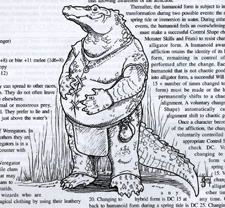 Although this type of lycanthropy can spread to other races, currently 99.99% are Bayou Halflings. They do not often leave opponents alive to spread the disease elsewhere.
Although this type of lycanthropy can spread to other races, currently 99.99% are Bayou Halflings. They do not often leave opponents alive to spread the disease elsewhere.
Weregators prefer to hunt animal or monstrous prey, shunning the taste for humanoid blood. They prefer to lie and wait for their prey, poking their eyes just above the water's surface to observe.
Bayou Halflings have legends of Weregators. In some stories, they are heroes, and in others they are monsters. Regardless, any talk of Weregators is in a whisper, and any Bayou Halfling encounter with one is likely to cause fainting.
Lizardfolk are immune to Weregator lycanthropy. Some of the more hostile clans hunt them for sport, suicidal as that may sound, and have directed their shamans to use the hides in creating magical shields. Weregators are also sought by wizards who are knowledgeable in the creation of magical clothing by using their leathery hides.
|
|
|
|
|
January 7, 2017
Mythic Monster Manual
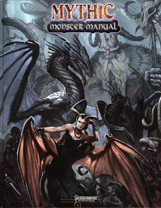 lead designer: Jason Nelson
lead designer: Jason Nelson
interior artists: Mike P. Lowe et al.
cover artist: Ben Wootten
publisher: Legendary Games
publication date: 2015
cover: hardcover
number of pages: 300
ISBN: 978-0986-1035-0-6
description: This bestiary provides mythic versions of over 220 different monsters. Mythic versions are more powerful than their ordinary counterparts. The book is compatible with the Mythic Rules (and Traditional Rules) of the Pathfinder RPG.
Our featured entry from this bestiary is the mythic version of the boojum snark, a creature first introduced in the poem, The Hunting of the Snark, written by Lewis Carroll from 1874 to 1876.
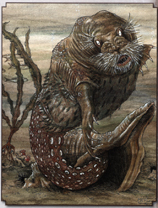 A boojum snark's body has the general form of a large walrus or sea lion, with a thick, coarse hide covering rolls of blubber, yet with gills along its upper flanks. Surrounding its jaws, that are lined with sharp teeth, is a mass of stiff bristles that give the creature a whiskered appearance. Its front flippers are equipped with long claws, but instead of rear flippers, its body tapers to a long prehensile tail akin to a suckered tentacle of a giant octopus. On the creature's chest, and from about midway along its body as it tapers toward the tail are feathers; dull and drab on some boojums--easy mistaken as just a variation in the hue of its otherwise dark skin--yet bright, colorful, and unmistakeable on others.
A boojum snark's body has the general form of a large walrus or sea lion, with a thick, coarse hide covering rolls of blubber, yet with gills along its upper flanks. Surrounding its jaws, that are lined with sharp teeth, is a mass of stiff bristles that give the creature a whiskered appearance. Its front flippers are equipped with long claws, but instead of rear flippers, its body tapers to a long prehensile tail akin to a suckered tentacle of a giant octopus. On the creature's chest, and from about midway along its body as it tapers toward the tail are feathers; dull and drab on some boojums--easy mistaken as just a variation in the hue of its otherwise dark skin--yet bright, colorful, and unmistakeable on others.
Like a bizarre hermit crab, the creature also carries a large empty seashell. On land, the boojum usually remains in its shell, using its strong and dextrous front flippers to drag itself around while its suckered tail grips the shell tightly from inside. In the water, it frequently emerges fully from its shell, but will not range far from it. It swims using sinuous whole-body movements while using its tentacle to hold the tip of its shell, which it pulls along behind it.
The body of a boojum is around 12 feet long, with its tail adding an additional 15 feet in total length. It weighs 4,000 lbs...
Snarks are very rare and highly elusive creatures yet they can sometimes be found lairing in the shallows around isolated volcanic islands filled with chasms and crags in uncharted reaches of oceans. Rarer still, are the boojums, mythic snarks who can cause those who meet their gazes to softly and suddenly vanish away, and never be met with again.
|
|
|
|
|
January 14, 2017
Southlands Bestiary
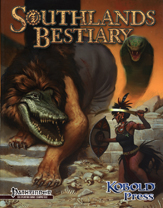 editor: Amanda Hamon Kunz
editor: Amanda Hamon Kunz
interior artists: Bryan Syme et al.
cover artist: Marcel Mercado
publisher: Kobold Press
publication date: 2015
cover: softcover
number of pages: 118
ISBN: 978-1-936781-37-9
description: This bestiary provides more than 100 creatures to populate deserts, savannahs and jungles. The book is compatible with the Pathfinder RPG.
Our featured entry from this bestiary is lemurfolk or kaguani.
 These small, intelligent, squirrel-like humanoids live in secret primitive societies deep in the jungles of the world. They are omnivorous, subsisting on fruits, roots, insects, larvae, eggs stolen from treetop nests, and birds and small mammals they bring down with their blowguns. They craft most of what they need from available materials in the deep jungle but sometimes barter with more advanced creatures for metal and crafted items. Lemurfolk are nocturnal but can function normally during daytime hours. They can live about 80 years, their fur graying with age. Lemurfolk stand about three feet tall and weight about 35 lbs.
These small, intelligent, squirrel-like humanoids live in secret primitive societies deep in the jungles of the world. They are omnivorous, subsisting on fruits, roots, insects, larvae, eggs stolen from treetop nests, and birds and small mammals they bring down with their blowguns. They craft most of what they need from available materials in the deep jungle but sometimes barter with more advanced creatures for metal and crafted items. Lemurfolk are nocturnal but can function normally during daytime hours. They can live about 80 years, their fur graying with age. Lemurfolk stand about three feet tall and weight about 35 lbs.
Lemurfolk Tribes of the Southlands
The lemurfolk tribes of the Southlands are a varied and rather pompous lot, and they are present in every jungle from the Southern Fringe to the wildest islands in the Tethys Sea. The most famous are the Feathertails of Zanskar, who are notorious pirates, bandits, and nuisances to the xorn--and a welcome relief to their slaves. The Feathertails are close followers of Eshu and Isis. They believe themselves to be divinely ordained to bring "merriment and honey" to the downtrodden, and they steal gold and jewels whenever the opportunity presents itself.
However, their thievery comes with gifts, as well--they provide honeycomb and fruits and nuts to the slaves of Zanskar, and thus they claim that they are "purchasing" the gold or precious stones that they take. The slaves are always happy to see the lemurfolk bring their goods or offerings.
The xorn find the whole thing extremely unamusing, and they sometimes offer bounties for lemurfolk hides or tails...
|
|
|
|
|
January 21, 2017
Aventurian Bestiary
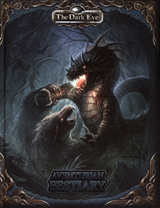 authors: Dominic Hladek, Marie Mönkemeyer, Alex Spohr, Jens Ullrich
authors: Dominic Hladek, Marie Mönkemeyer, Alex Spohr, Jens Ullrich
translator: Daniel Mayer
interior artists: various
cover artist: Nadine Schäkel
publisher: Ulisses Spiele GmbH
publication date: 2015
cover: hardcover
number of pages: 128
ISBN: 978-3957-522955
description: This bestiary introduces 40 monsters and two dozen animals which can be found in the forest, swamps and jungles of Aventuria. The book is compatible with The Dark Eye RPG.
Our featured entry from this bestiary is the blossom fairy.
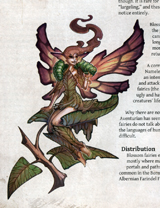 The most well known type of fairy is the small blossom fairy. They resemble tiny elves with transparent wings, and wear clothes that look like colorful, cup-shaped blossoms. Almost everyone hears stories about fairies as a child, and blossom fairies always play a part. Some call them Ladifaahri, which comes from Isdira, the language of the elves, who usually get along perfectly with these diminutive inhabitants of Dere. Blossom fairies and elves view each other as distant relatives. The exclusively female blossom fairies do tend to stay away from humans, dwarves and other two-legged creatures, though. It is rare for a Ladifaahri to be surprised by a "largeling", and these shy fairy creatures often escape notice entirely.
The most well known type of fairy is the small blossom fairy. They resemble tiny elves with transparent wings, and wear clothes that look like colorful, cup-shaped blossoms. Almost everyone hears stories about fairies as a child, and blossom fairies always play a part. Some call them Ladifaahri, which comes from Isdira, the language of the elves, who usually get along perfectly with these diminutive inhabitants of Dere. Blossom fairies and elves view each other as distant relatives. The exclusively female blossom fairies do tend to stay away from humans, dwarves and other two-legged creatures, though. It is rare for a Ladifaahri to be surprised by a "largeling", and these shy fairy creatures often escape notice entirely.
Blossom fairies don't stray very far from the portals to their realm because they cannot stay on Dere permanently. The longer they stay in the real world, the more life essence they lose, so they return to the fairy realm regularly.
A corrupted type of fairy serves the Nameless One. These creatures, which share an intense hatred for their beautiful cousins and attack them when possible, are called dark fairies (the elves call them Lamifaar). They are ugly and have shrill voices, and feed on other creatures' life essence...
Nobody knows why blossom fairies visit Dere. They are most likely curious about mortals and the wonderful plants of Aventuria, since they are most often seen near flowers. They are often seen gathering nectar like bees, or lingering to breathe in the fragrance of the flowers. Ladifaahri are shy but curious and friendly. They try to stay hidden and watch mortals. Sometimes, blossom fairies deem humans so interesting that they try to lure them into the fairy realm. The ladifaahri do not know that time runs differently there, and this can have terrible consequences for people. A visit of weeks, months, or years in the fairy realm might feel like mere hours to a human. Similarly, a human might spend only a few hours in the fairy realm and return to find that centuries have passed in the mortal realm.
|
|
|
|
|
January 28, 2017
The Strange Bestiary
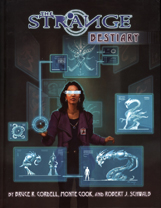 authors: Bruce R. Cordell, Monte Cook and Robert J. Schwalb
authors: Bruce R. Cordell, Monte Cook and Robert J. Schwalb
lead artist: Matt Stawicki
cover artist: uncredited
publisher: Monte Cook Games
publication date: 2014
cover: hardcover
number of pages: 160
ISBN: 978-1939-979285
description: This bestiary introduces 140 creatures and characters of Earth as well as natives to the recursions of Ardeyn, Ruk, Crow Hollow, Atom Nocturne and more. The book is compatible with both The Strange and Numenéra: The Ninth World RPGs.
Our featured entry from this bestiary is the cyber sorceror.
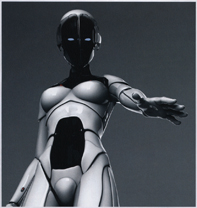 Magic and technology are not always at odds. In some recursions, magic is just another power source, and as such, it can drive a machine--even a very sophisticated one. A cyber sorcerer is an intelligent android literally fueled by magic that powers a variety of spells and incantations.
Magic and technology are not always at odds. In some recursions, magic is just another power source, and as such, it can drive a machine--even a very sophisticated one. A cyber sorcerer is an intelligent android literally fueled by magic that powers a variety of spells and incantations.
Cyber sorcerers typically look like whatever they wish, but their natural form is that of an advanced mechanical humanoid. Most are quite mad with power.
Cyber sorcerers are intelligent, paranoid and not automatically hostile. They have their own self-serving agendas, which often involve elaborate schemes.
|
|
|
|
|
February 4, 2017
Tome of Beasts 5th Ed.
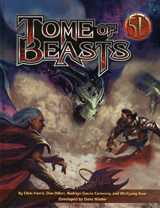 authors: Chris Harris, Rodrigo Garcia Carmona & Wolfgang Baur
authors: Chris Harris, Rodrigo Garcia Carmona & Wolfgang Baur
developer: Steve Winter
interior artists: Bryan Syme et al.
cover artist: Marcel Mercado
publisher: Kobold Press
publication date: 2016
cover: hardcover
number of pages: 430
ISBN: 978-1936-781560
description: This bestiary presents more than 400 beasts. The book is compatible with 5th edition of Dungeons and Dragons.
Our featured entry from this bestiary is the abominable beauty.
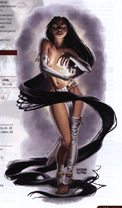 Beauty that Destroys. An abominable beauty is so perfect that her gaze blinds, her voice is so melodious that no ears can withstand it, and her touch is so tantalizing that it burns like fire. In adolescence, this fey creature adopts features that meet the superficial ideals of the nearest humanoid population: long-legged elegance near elves, a stout figure with lustrous hair near dwarves, unscarred or emerald skin near goblins.
Beauty that Destroys. An abominable beauty is so perfect that her gaze blinds, her voice is so melodious that no ears can withstand it, and her touch is so tantalizing that it burns like fire. In adolescence, this fey creature adopts features that meet the superficial ideals of the nearest humanoid population: long-legged elegance near elves, a stout figure with lustrous hair near dwarves, unscarred or emerald skin near goblins.
Jealous and cruel. Abominable beauties are so consumed with being the most beautiful creature in the region that they almost invariably grow jealous and paranoid about potential rivals. Because such an abominable beauty cannot abide competition, she seeks to kill anyone whose beauty is compared to her own.
Males of the Species. Male abominable beauties are rare but even more jealous in their rages.
|
|
|
|
|
February 11, 2017
GURPS Space Bestiary: A Guide to Creatures of the Endless Frontier
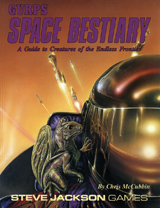 author: Chris W. McCubbin
author: Chris W. McCubbin
interior artist: Thomas Baxa
cover artist: Bob Eggleton
publisher: Steve Jackson Games
publication date: 1990
cover: softcover
number of pages: 112
ISBN: 80742-06503
description: This bestiary presents more than 300 extraterrestrial creatures for a science fiction roleplaying campaign. The book is compatible with the GURPS RPG.
Our featured entry from this bestiary is the vacuum cetacean.
 Vacuum cetaceans, or "space whales", look and act much like Terran whales, but they live in deep space. They move through the use of an internal organ that manipulates the gravitational "current" generated by all stellar bodies. It feeds on gases emitted from stars, gas giants and planets.
Vacuum cetaceans, or "space whales", look and act much like Terran whales, but they live in deep space. They move through the use of an internal organ that manipulates the gravitational "current" generated by all stellar bodies. It feeds on gases emitted from stars, gas giants and planets.
Space whales are massive--as large as a star cruiser. Their huge bodies cannot survive gravity greater than about 0.2 G. The average space whale lives 1,000 years. They travel in pods of two to ten, and give birth every century. A few space whales travel alone--these are usually "rogues" outcast from the pod, and are known to be violent.
The whales slowly "swim" through space, passing close enought to stars, gas giants or planets to absorb the gasses they need to live. They can ride between stars--their "gravitic drive" can push them up to hyperspeed, traveling a maximum of about three times the speed of light.
Space whales are normally docile. There are tales of astronauts who have touched or ridden a space whale. They are intelligent, and seem to enjoy friendly encounters with other lifeforms. However, if a cetacean is attacked or the mother whale is approached recklessly, they can become violent. Rogues and mothers have been known to crush small craft and ram battlecruisers.
|
|
|
|
|
February 18, 2017
City of Brass
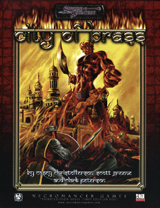 authors: Casey Christofferson, Scott Greene and Clark Peterson
authors: Casey Christofferson, Scott Greene and Clark Peterson
interior artists: Eric Poak et al.
cover artist: Peter Bradley
publisher: Necromancer Games
publication date: 2007
cover: softcover + box
number of pages: 430
ISBN: 978-1588-467490
description: This product is a boxed set containing 430 pages of information, adventures, NPCs and beasts relevant to the City of Brass, the Efreet Capital of the Elemental Plane of Fire. The set contains three softcover books and a booklet of maps. The third volume, City of Brass: Secrets of the Brazen Throne, contains eight appendices. Relevant to this survey, the first appendix contains 61 pages of NPCs and the second appendix contains 93 pages of beasts. The set is compatible with the d20 system utilizing the 3.5th rules.
Our featured entry from this bestiary is the sand giant.
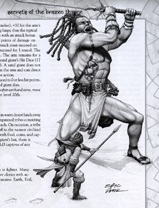 Sand giants are brutal, somewhat barbaric giants that prey on those weaker than themselves. They have dark tan skin, brown hair, and dark brown or dark green eyes. An adult male stand approximately 20 feet tall. Males tend to wear their hair and beards braided. Sand giants wear light clothes and light armor (if any). In times of battle or war, males may don chainmail. A typical sand giant's bag contains food, 3d4 mundane items, and a modest amount of cash (no more than 12d10 coins).
Sand giants are brutal, somewhat barbaric giants that prey on those weaker than themselves. They have dark tan skin, brown hair, and dark brown or dark green eyes. An adult male stand approximately 20 feet tall. Males tend to wear their hair and beards braided. Sand giants wear light clothes and light armor (if any). In times of battle or war, males may don chainmail. A typical sand giant's bag contains food, 3d4 mundane items, and a modest amount of cash (no more than 12d10 coins).
Sand Giants speak Giant and Common. Sand giants can live to be 500 years old.
Sand giants make their homes in warm desert lands away from civilization. They live in organized tribes consisting of 8-9 families of 2-4 members each. On occasion, a tribe forms a raiding party that sets off to the nearest civilized place, returning at a later time with food, coins, and captives. For each adult in a sand giant's lair, there is a 40% chance that the lair has 1d3 captives of any humanoid race.
|
|
|
|
|
February 25, 2017
A Tolkien Bestiary
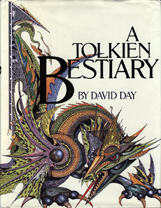 author: David Day
author: David Day
interior artists: Allan Curless et al.
cover artist: Ian Miller
publisher: Gramercy Books
publication date: 2001 (orig. 1979)
cover: hardcover
number of pages: 288
ISBN: 978-0517-120774
description: This book is a comprehensive reference guide to the races, flora and fauna that inhabited J.R.R. Tolkien's Middle-Earth and the Undying Lands.
Our featured entry from this bestiary is the Witch-King of Morgul.
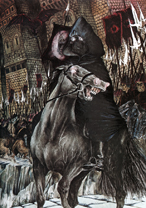 The mightiest servant of Sauron was the Nazgûl lord called the Witch-king. This wraith served Sauron through the Accursed Years of the Second Age of Sun, but with the fall of the Ring Lord at the end of that Age he faded from the World. In the year 1300 of the Third Age this wraith was resurrected by Sauron and went to Angmar, where he became known as the Witch-king of Angmar. Through many centuries of war he destroyed the Dúnedain of Arnor, though Angmar was destroyed soon after. He then rose again in the South and took command of the tower of Mina Morgul in Gondor.
The mightiest servant of Sauron was the Nazgûl lord called the Witch-king. This wraith served Sauron through the Accursed Years of the Second Age of Sun, but with the fall of the Ring Lord at the end of that Age he faded from the World. In the year 1300 of the Third Age this wraith was resurrected by Sauron and went to Angmar, where he became known as the Witch-king of Angmar. Through many centuries of war he destroyed the Dúnedain of Arnor, though Angmar was destroyed soon after. He then rose again in the South and took command of the tower of Mina Morgul in Gondor.
In the War of the Ring, the Witch-king was the most immediate and most deadly foe of the Men of Gondor. To him came the Orc legions, Uruk-hai, Olog-hai and Trolls out of Mordor. To him also came the Easterlings, the Variags and the Haradrim allies. As the Ringbearer passed into Mordor he watched the Witch-king and his mighty army pour out of the dark citadel of Minas Morgul and march to war against the Men of the White Tower of Gondor.
|
|
|
|
|
March 4, 2017
Gloranthan Bestiary: Creatures from Around the World
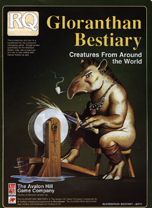 authors: Sandy Petersen and Greg Stafford
authors: Sandy Petersen and Greg Stafford
interior artist: Kevin Ramos
cover artist: Steve Purcell
publisher: The Avalon Hill Game Company/Chaosium Inc.
publication date: 1988
cover: softcover
number of pages: 48
ISBN: 0-911605-60-6
description: This bestiary contains more than 60 entries. It includes descriptions, game statistics, and innumerable notes for each creature. Many entries are accompanied by an illustration. The book is written for Standard Edition Runequest and can also be used with Deluxe Edition Runequest.
Our featured entry from this bestiary is the hoolar (Lodril imprimus).
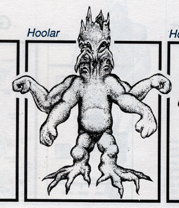 PAMALTELA -- The hoolar are huge, half-legendary beings. They possess three faces, two legs and four arms, and are fantastically strong (though peaceful), though not too bright. They can make enchanted objects.
PAMALTELA -- The hoolar are huge, half-legendary beings. They possess three faces, two legs and four arms, and are fantastically strong (though peaceful), though not too bright. They can make enchanted objects.
Hoolar can be found anywhere in Pamaltela except the marshes, but are so rare that generations may pass by without a single hoolar sighting. In mythology, hoolars were the first form of intelligent life to populate Palmaltela.
Many traditional Trickster stories include Hoolar as a big, good-natured fellow whom Trickster is always despicably trying to cheat, always failing. One classic story, "Trickster and Hoolar's Pantry", describes Trickster's attempted theft of Hoolar's food. Trickster searches and searches, but cannot find anything edible in Hoolar's house. When Hoolar returns home unexpectedly, Trickster disguises himself as a rock in the corner, hoping to spy on Hoolar and see where he keeps the food (and what he eats). But Hoolar see the rock, licks his lip, and eats it. That's the end of Trickster.
|
|
|
|
|
March 11, 2017
Baby Bestiary
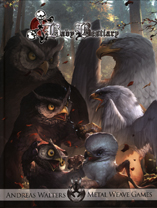 creative director: Andreas Walters
creative director: Andreas Walters
interior artists: Conceptopolis et al.
cover artist: Conceptopolis
publisher: Metal Weave Games
publication date: 2016
cover: hardcover
number of pages: 76
ISBN: 978-1-987916-17-1
description: This bestiary contains entries for 32 relatively well-known beasts in their baby stages. The book is designed to be system- and setting-neutral, so it does not contain stat blocks.
Our featured entry from this bestiary is the treant sapling.
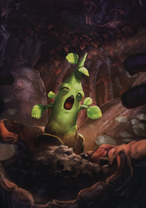 Like their mundane cousins, treants may be born of seed, although methods vary. Willow-like treants join limbs over the course of the spring and summer seasons, yielding seeds which fall beneath them as they explore their union. Other types mimic natural trees' seed production. In an event, seeds will only develop into saplings if the correct, rare conditions are met...
Like their mundane cousins, treants may be born of seed, although methods vary. Willow-like treants join limbs over the course of the spring and summer seasons, yielding seeds which fall beneath them as they explore their union. Other types mimic natural trees' seed production. In an event, seeds will only develop into saplings if the correct, rare conditions are met...
Treant saplings require sunlight, water, and soil, although exactly what kind depends upon the variety of treant. Natural compounds can be used to augment the soil. Experiment on mundane trees with fish meal, vegetable peels, blood, or even mineral dust to ensure your treant sapling has everything needed for robust growth. Dig carrion you find from small animals and birds into the soil around the base. They must root for the first two months of their lives and being to walk at 2-8 months.
Sapling start to understand speech after 10 months. It won't be able to form words of its own until it's reached at least a year of age. If a sapling is not exposed to speech within the first two years of its life, it will learn language more slowly than a human child would...
|
|
|
|
|
March 18, 2017
Monstrous Compendium Annual Volume One
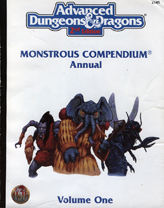 editor: David Wise
editor: David Wise
project coordinator: Roger Moore
interior artist: Tony DiTerlizzi
cover artist: Jeff Easley
publisher: TSR
publication date: 1994
cover: softcover
number of pages: 128
ISBN: 978-15607-68388
description: This bestiary contains entries for over one hundred denizens of the land, sky, sea and underdark. The creatures are collected from monsters that appeared in TSR's 1993 Advanced Dungeons and Dragons product line, plus many that appeared in the 1993 issues of Dragon, Dungeon and Polyhedron magazines. The book is compatible with Advanced Dungeons and Dragons second edition.
Our featured entry from this bestiary is the campestri.
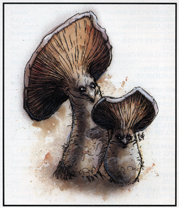 Campestris resemble myconids (see the Monstrous Manual tome) without arms and have a stronger resemblance to mushrooms than their more highly evolved cousins. Campestris are happy-go-lucky creatures with few cares or worries. The fungus creatures have developed a warped sense of humor and some rudimentary powers of reason. Each "herd" of mushrooms also has a collective intelligence equal to about 6-7 on the Intelligence scale. A druid or other character with the herbalism proficiency may have heard of dancing mushrooms in old legends...
Campestris resemble myconids (see the Monstrous Manual tome) without arms and have a stronger resemblance to mushrooms than their more highly evolved cousins. Campestris are happy-go-lucky creatures with few cares or worries. The fungus creatures have developed a warped sense of humor and some rudimentary powers of reason. Each "herd" of mushrooms also has a collective intelligence equal to about 6-7 on the Intelligence scale. A druid or other character with the herbalism proficiency may have heard of dancing mushrooms in old legends...
Campestris vary widely in color, from white to tan to dark brown, but they always have red or purple caps and speckles. They move by expanding and contracting their "root-balls".
Once per day, each campestri can release a cloud of spores that acts as a slow spell upon all creatures within a 10-foot radius. The effect lasts for 1d4+4 rounds... Campestris are very sensitive to sound and vibrations, so they are surprised only on a roll of 1 or 2.
Campestris are captivated by any sort of singing, even incredibly bad singing. If anyone sings or plays an instrument, the campestris will happily sing along. The mushrooms can easily imitate both words and music. Once they have run through a song or piece of music three or four times, they remember it, although they have a tendency to mix and match parts of different tunes. The campestris will dance all around whoever is singing to them, enjoying themselves immensely. If one of the PCs sings a song to the campestris, the DM should sing back the words a little warped. For example, suppose a PC bard sings, "Mary had a little lamb, whose fleece was white as snow" (one of the campestris' all-time favorites). In response, the campestris madly caper around the PC while singing, "Murray hada weedleam, hoose fleas was wideasno!" (The DM should repeat the lyrics in an obnoxious, nasal falsetto, twisting them in a new way each time until he or she gets tired or the players start to throw things.)
|
|
|
|
|
March 25, 2017
Monstrous Compendium Annual Volume Two
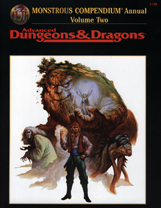 editor: Jon Pickens
editor: Jon Pickens
creative director: Steve Winter
interior artists: Arnie Swekel et al.
cover artist: Jeff Easley
publisher: TSR
publication date: 1995
cover: softcover
number of pages: 128
ISBN: 978-0786-901999
description: This bestiary contains entries for over one hundred denizens of the land, sky, sea and other places. The creatures are collected from monsters that were published by TSR in 1994. The book is compatible with Advanced Dungeons and Dragons second edition.
Our featured entry from this bestiary is the umpleby.
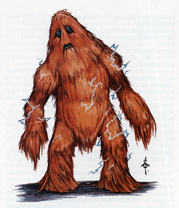 The umpleby is an eight-foot-tall, 400 pound walking mound of wild, straggly brown hair. Lips and eyes can be discerned on its face, but every other part of its body is covered with fur.
The umpleby is an eight-foot-tall, 400 pound walking mound of wild, straggly brown hair. Lips and eyes can be discerned on its face, but every other part of its body is covered with fur.
When encountered in its native temperate forest, the umpleby will neither attack nor try to hide, but will just stand
stupidly and stare.
The umpleby can speak common in a halting fashion, but will rarely do so; in general it is an uncommunicative creature.
The umpleby stores large quantities of static electricity in its body. Each day, it can deliver a total of 50 hit points of electrical damage simply by touching its opponents...The umpleby can deliver all 50 points of damage in one
strike, or it may regulate the amount of electrical damage it inflicts, usually conducting ld8+8 points of damage.
When it delivers the 50th hit point of electrical damage, the umpleby immediately goes to sleep, recharging its static electrical charge...
Habitat & Society: An umpleby usually lives in a cave or hole dug into the earth or into the side of a hill. It is a rather stupid creature, and solitary by nature; the umpleby attention span is too short to be interested in forming a community. Occasionally, a male and a female umpleby will encounter each other in the forest and band together just long enough to bear a young one. They stay together until the "baby" wanders off one day and doesn't come back, then they lose interest in each other and wander off themselves. No more than three umplebys have been seen together at one time.
|
|
|
|
|
April 1, 2017
Monstrous Compendium Annual Volume Three
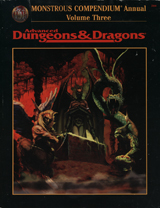 editor: Jon Pickens
editor: Jon Pickens
creative director: Steve Winter
interior artists: Tony DiTerlizzi et al.
cover artist: Matt Adelsperger
publisher: TSR
publication date: 1996
cover: softcover
number of pages: 128
ISBN: 978-0786-904495
description: This bestiary contains entries for over one hundred denizens of the land, sky, sea and outer planes. The creatures are collected from monsters that appeared in TSR's 1995 Advanced Dungeons and Dragons product line, plus many that appeared in the 1993 issues of Dragon, Dungeon and Polyhedron magazines. The book is compatible with Advanced Dungeons and Dragons second edition.
Our featured entry from this bestiary is the lillend.
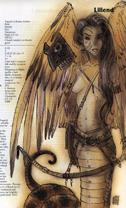 Lillendi are natives Ysgard, though they can travel astrally to the Prime and also may be found on the planes of Arborea and Limbo. On the Prime Material Plane, they prefer to dwell in temperate or tropical woodlands. They are peaceful and delight in song and conversation--and far from harmless. Those who offend lillendi may receive harsh treatment at their hands, and even blameless individuals are subject to their pranks. Lillendi are particularly hostile toward those who seek to impose civilized order on wilderness.
Lillendi are natives Ysgard, though they can travel astrally to the Prime and also may be found on the planes of Arborea and Limbo. On the Prime Material Plane, they prefer to dwell in temperate or tropical woodlands. They are peaceful and delight in song and conversation--and far from harmless. Those who offend lillendi may receive harsh treatment at their hands, and even blameless individuals are subject to their pranks. Lillendi are particularly hostile toward those who seek to impose civilized order on wilderness.
A lillend has the torso, arms, and head of a comely man or woman, but also has broad, powerful, feathered wings and a stout serpentine body from the waist downwards. Though the humanlike portions of a lillend are of unremarkable hue, the feathered and scaled parts of its anatomy are brightly colored and strikingly patterned. Each individual has a unique color combination and is quite prod of it. Lillends wear no clothing but sometimes wear jewelry. They always carry weapons and musical instruments.
Habitat/Society: Lillendi serve the gods of the moon in the realm called Gates of the Moon, which lies on the plane of Ysgard. They only travel to the Prime when ordered to do so by their Powers. Of all the proxies of Ysgard, the lillendi are the least involved in the affairs of others.
Lillendi are said to be able to choose the hour of their death, the Silent Hour, when they grow weary of life and service to the moon. This knowledge is either a gift from the gods of the moon, or a curse from the powers of Law, whom the lillendi are said to have served long ago and then abandoned. Shortly before her death, a lillend makes her farewell. As she dies she is absorbed into her power's realm, disappearing in a misty fog that acts as a combination moonbeam and chaos spell.
Lillendi who haven't yet chosen the Silent Hour can still die through accident or violence, but in death their faces are always wracked with despair, for the legends say that those who do not pass through the Silent Hour are never joined with the power they serve.
Lillendi social status depends on a simple system of initiations into mysteries and the ownership of certain totem mask. The mysteries are akin to secret societies, and each mystery is a specific kernel of wisdom passed on from one generation to the next. The more societies a lillend is a member of, the greater her status. Each society is devoted to particular musical forms, songs, instruments, and weapons, so a group of lillendi usually uses the same instruments, weaponry, and spells.
The masks are tangentially related to the societies, since each mask design belongs to a specific family, and long ago
each family lived in a single lodge and wore a single type of mask. Things have gotten a little more complicated since
then. but the masks still roughly indicate status and family affiliations.
|
|
|
|
|
April 8, 2017
Monstrous Compendium Annual Volume Four
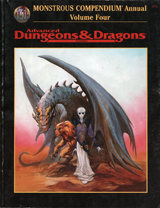 editor: Jon Pickens
editor: Jon Pickens
creative director: Steve Winter
interior artists: Glen Michael Angus et al.
cover artist: Jeff Easley
publisher: TSR
publication date: 1998
cover: softcover
number of pages: 96
ISBN: 978-0786-912124
description: In this volume, over 100 creatures are presented, originating with the Forgotten Realms, Birthright, Dragonlance, Ravenloft, Dark Sun, Red Steel and Greyhawk campaign settings. The book is compatible with Advanced Dungeons and Dragons second edition.
Our featured entry from this bestiary is the fraal.
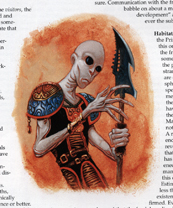 Sometimes known simply as the visitors, the psionic fraal are highly evolved and sophisticated humanoids from somewhere else. Some sages speculate that these visitors came from another plane of existence or perhaps another world within the Prime Material Plane. Of seeming fragile build, the fraal rely on devices of unusual workmanship and power to protect themselves. These devices are not magical; in fact, the fraal know almost nothing of magic.
Sometimes known simply as the visitors, the psionic fraal are highly evolved and sophisticated humanoids from somewhere else. Some sages speculate that these visitors came from another plane of existence or perhaps another world within the Prime Material Plane. Of seeming fragile build, the fraal rely on devices of unusual workmanship and power to protect themselves. These devices are not magical; in fact, the fraal know almost nothing of magic.
The fraal are thin humanoids, averaging about five feet in height. They can be distinguished by their large eyes, their pale, almost luminous skin, their swept-back ears, and their round heads. Most fraal encountered so far have been bald, although some individuals have been encountered who have wisps of silver, white, or pale-yellow hair. A most disconcerting element is that all fraal display a wizened countenance like the eldest of wizards.
The fraal are natural telepaths, and can communicate telepathically with creatures of low intelligence or better. Whether they have a verbal language of their own is uncertain, though they have never been seen to converse verbally among themselves. They have been known to speak Common to those not of their kind, though they speak it slowly and with some difficulty. Their words display a quiet demeanor and they are not given to excitement or violent emotion.
Combat: The fraal void confrontation whenever possible, negotiating when able and fleeing when communication fails. Indeed, fraal seem more interested in observing violence than taking part in it themselves. Witnesses agree that fraal have been drawn to violence and spectacular conflict. Their behavior is almost childlike as they watch physical combat with wonder and an almost clinical detachment. If fraal should find combat unavoidable, they rely upon their psionic talents, which they call mindwalking, to defend themselves. Even more rarely, fraal use alien devices of great power to dissuade attackers...
No more than one fraal in three will have a device that can deliver a ranged attack. Two different types of fraal ranged devices have been seen: firerods and firestaves. These devices and others that the fraal employ do not radiate any magical signature. The fraal seem reluctant to use their fire devices unless absolutely necessary. Most learned sages suspect that this involves a religious taboo against fire, but no one knows for sure. Communication with the fraal has revealed little, as they babble on about a morality of "limited resource development" and "conservationism" whenever the subject is broached...
|
|
|
|
|
April 15, 2017
Game Mastery Guide
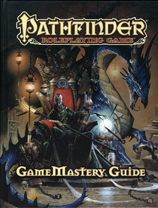 creative director: James Jacobs
creative director: James Jacobs
authors: Cam Banks et al.
interior artists: Alex Aparin et al.
cover artist: Wayne Reynolds
publisher: Paizo Publishing
publication date: 2010
cover: hardcover
number of pages: 320
ISBN: 978-1601-252173
description: Relevant to this survey, Chapter 9. NPC Gallery presents 81 flavors of human being. The book is compatible with the Pathfinder Role Playing Game.
Our featured entry from this bestiary is the barmaid.
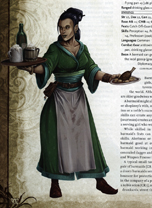 Barmaids are serving wenches, dancing girls, and even harried cooks in inns and taverns throughout the cities and towns of the world. Although usually young, some barmaids are older goodwives working in the family business...
Barmaids are serving wenches, dancing girls, and even harried cooks in inns and taverns throughout the cities and towns of the world. Although usually young, some barmaids are older goodwives working in the family business...
While skilled in improvised weapons, changing a barmaid's feats can create a servant with other useful skills. Alertness or Skill Focus (Perception) makes a barmaid good at overhearing conversations, while a barmaid working in a dangerous dive might carry a concealed dagger and have the Improved Unarmed Strike and Weapon Finesse feats.
A typical small tavern may have only a barkeep and a pair of barmaids (CR 4), while a large inn might have half a dozen barmaids serving the barkeep, with a street thug bouncer for protection (CR 6). A barmaid is often found in the company of a pair of farmers or shipmates (CR 2) or a noble scion (CR 3), or two barmaids might serve a pair of drunkards, street thugs, or vagabonds (CR 4).
|
|
|
|
|
April 22, 2017
Ponyfinder Everglow Bestiary
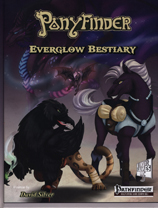 authors: David Silver, Byron Mulvogue & Tim Boura
authors: David Silver, Byron Mulvogue & Tim Boura
interior artist: Arcadian Phoenix
cover artist: Arcadian Phoenix
publisher: Silver Games
publication date: 2016
cover: hardcover
number of pages: 40
ISBN: 237-0007-500666
description: This bestiary contains entries for twenty-one creatures, one template, one prestige class and one playable race. The book is compatible with the Pathfinder Role Playing Game.
Our featured entry from this bestiary is the zombie pony.
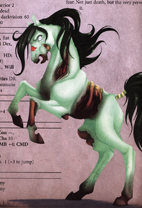 A grunting moan is the first sign that this corpse has not been set to ease with Soft Whisper. Rising to limbs animated with dark magics, the beast stares from the rotting flesh that is all that remains of its face. It sounds hungry.
A grunting moan is the first sign that this corpse has not been set to ease with Soft Whisper. Rising to limbs animated with dark magics, the beast stares from the rotting flesh that is all that remains of its face. It sounds hungry.
Raised by necromancers who clearly do not pay the most cursory of lip-service to the goddess of death, this abomination of the forces of nature known simply as a 'zombie' is at once everything that any sane adventurer should
fear. Not just death, but the very perversion of it.
|
|
|
|
|
April 29, 2017
Rogue's Gallery
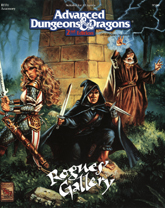 design: Thomas Prusa, Walter Baas, Jack Barker
design: Thomas Prusa, Walter Baas, Jack Barker
interior artists: Ken Frank et al.
cover artist: Clyde Caldwell
publisher: TSR
publication date: 1992
cover: loose pages in folder
number of pages: 96
ISBN: 978-1560-763772
description: This bestiary contains all manner of nonplayer character warriors, wizards, priests, and rogues with all their class variations. The book is compatible with Advanced Dungeons and Dragons second edition.
Our featured entry from this bestiary is Theopolis the Thoughtful, a 10th level Gnome Clairsentient.
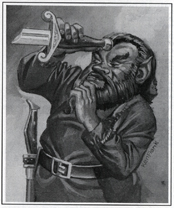 Physical Description: Theopolis is about average in height for a gnome, but his portly bulk, long black hair, and impeccably groomed beard often make others mistake him for a very short dwarf, much to his chagrin. Most of Theopolis's clothes are simply gnomish attire, but since moving to the city, he has purchased a few more striking outfits, which he wears on special occasions.
Physical Description: Theopolis is about average in height for a gnome, but his portly bulk, long black hair, and impeccably groomed beard often make others mistake him for a very short dwarf, much to his chagrin. Most of Theopolis's clothes are simply gnomish attire, but since moving to the city, he has purchased a few more striking outfits, which he wears on special occasions.
Background: Theopolis is a gnome who grew up in an isolated tribe, blissfully unaware of the forces of chaos at work in the world. He became aware of his psionic potential at an early age, but never saw any particular reason to develop it. He was happy, his tribe was happy, and it seemed that nothing could ever change. But of course, it did.
A group of human refugees, led by the onetime monarch Jodav, set up residence near the gnomes' underground home. The leader of the tribe, Ellayni Silverdelve, decided that the gnomes should keep their presence a secret from the humans, and ordered the gnomes to go into hiding. This mandate did not sit well with Theopolis, who wanted to meet the humans and interact with them. Seeing his discontent, Ellayni gave Theopolis a pair of magic knives to protect himself, and allowed him to seek his fortune, forbidding him only from contacting or revealing her people's presence to Jodav and his followers.
Out in the wide world, Theopolis quickly learned how to use his psionic senses to survive, becoming especially adept at tracking animals, people, even inanimate objects by their mental traces. Eventually, he stumbled upon civilization where he found a ready market for extraordinary talents. His new profession as expert tracker frequently brought him into contact with the seedier side of life and he had to learn how to set aside revulsion and disgust when he was called upon to locate corpses, skeletons, and other low-lifes.
One of his most frequent customers is the Electrum Wizad, Joachim, who first hired Theopolis to help him find a ring of djinni summoning that had fallen into the hands of a fanatic religious cult. Theopolis succeeded in recovering the ring where four other psionicists had failed, and has been Joachim's "clairsentient of choice" ever since. Theopolis, for his part, prefers to work for people like Joachim, who do not claim to be ridding the world of evil (or plotting to conquer it), but instead are working to maintain a balance between good and evil.
|
|
|
|
|
May 6, 2017
Monstrous Compendium Outer Planes Appendix
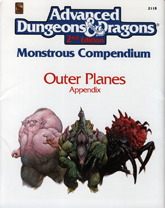 design: J. Paul LaFountain
design: J. Paul LaFountain
developer and editor: Timothy B. Brown
interior artist: Thomas Baxa
cover artist: Jeff Easley
publisher: TSR
publication date: 1991
cover: loose pages in folder
number of pages: 96
ISBN: 978-1560-760559
description: This compendium contains denizens of the outer planes, the brightest ambassadors of good and the foulest custodians of evil. The book is compatible with Advanced Dungeons and Dragons second edition.
Our featured entry from this bestiary is the piscoloth, a lesser yugoloth (daemon).
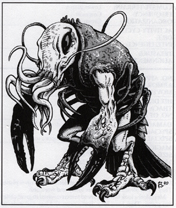 Piscoloths are the sergeants and overseers of the armies of yugoloth mercenaries. These creatures hold sway over companies of dergholoths and mezzoloths with dictatorial inflexibility. The fish-tailed, walleyed piscoloth has the red, chitinous body of a lobster, the talons of a bird, and the head of a carrion crawler.
The piscoloth's arms, while human-like, end in a set of crab-like
pincers. This creature is found throughout the lower planes wherever there lurk the armies of the yugoloths.
Piscoloths are the sergeants and overseers of the armies of yugoloth mercenaries. These creatures hold sway over companies of dergholoths and mezzoloths with dictatorial inflexibility. The fish-tailed, walleyed piscoloth has the red, chitinous body of a lobster, the talons of a bird, and the head of a carrion crawler.
The piscoloth's arms, while human-like, end in a set of crab-like
pincers. This creature is found throughout the lower planes wherever there lurk the armies of the yugoloths.
Piscoloths communicate using telepathy.
Habitat/Society: Piscoloths are sergeants and overlords. They are in charge of maintaining order--or some semblance thereof--among the armies of the yugoloths. They have very short life spans, however, having to answer to the easily-angered, more powerful yugoloths. Keeping order in a yugoloth army is akin to passing a planet through the eye of a needle. Piscoloths do, however, derive pleasure from their tasks, for they are cruel and hateful. They bully weaker creatures whenever possible.
Piscoloths are one of the few yugoloths that will cooperate in groups. They are commonly found in groups of five or six and will be ruling over one or more companies of mezzoloths. They will generally maintain order through destruction of those who do not obey them. Of course, being few at the head of hordes of their own abused underlings makes piscoloths subject to frequent friendly fire.
Piscoloths play a direct role in the Blood War. They are the yugoloths that are most often presented with an opportunity to turn against their employers.
|
|
|
|
|
May 13, 2017
Monstrous Compendium Fiend Folio Appendix
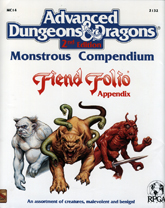 coordination: Skip Williams and Jean Rabe
coordination: Skip Williams and Jean Rabe
interior artists: Thomas Baxa, Mark Nelson & S.R. Bissette
cover artist: Jeff Easley
publisher: TSR
publication date: 1992
cover: loose pages in folder
number of pages: 68
ISBN: 978-1560-764281
description: This compendium contains creatures, many drawn from the 1st edition Fiend Folio and some new. The book is compatible with Advanced Dungeons and Dragons second edition.
Our featured entry from this bestiary is the terithran.
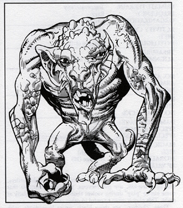 The terithran is a short (4' tall) humanoid creature with long sinewy arms, a disproportionately large and misshapen head, and clawlike hands and feet. In its home on the Ethereal Plane, it is a scaly greenish-gray creature, but when it ventures to the Prime Material Plane it has only a faint shadowy appearance. Most terithrans speak only their own language, although some do speak Common as we11 (15% chance.)
The terithran is a short (4' tall) humanoid creature with long sinewy arms, a disproportionately large and misshapen head, and clawlike hands and feet. In its home on the Ethereal Plane, it is a scaly greenish-gray creature, but when it ventures to the Prime Material Plane it has only a faint shadowy appearance. Most terithrans speak only their own language, although some do speak Common as we11 (15% chance.)
Habitat/Society: The terithran is a solitary creature. Protective of its "hunting grounds" (those areas of the Ethereal Plane that correspond to areas of the Prime Material Plane which are rich in magical energy) the terithran keeps to itself and its own territory, except when the mating urge is upon it. Only rarely (5%) will more than one terithran be encountered. Terithran young are tended by the mother for six months, and then ejected from
the mother's lair to fend for themselves.
The terithran's main diet is wizards from the Prime Material Plane, mainly because wizards are such easy prey once the
terithran has drained away their spells. The terithran stalks wizards by detecting the magical swirls and eddies on the Ethereal Plane which are caused by the use of large amounts of magic on the Prime Material Plane...
Ecology: The terithran is thought to be a tasty treat by most dracolisks. For this reason, once terithrans have secured a safe lair on the Ethereal Plane, they very seldom venture from it.
|
|
|
|
|
May 20, 2017
Hellfrost Bestiary
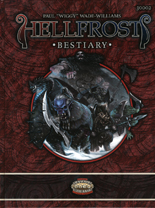 author: Paul "Wiggy" Wade-Williams
author: Paul "Wiggy" Wade-Williams
interior artists: Chris Kuhlmann & Justin Russell
cover artist: Robin Elliott
publisher: Triple Ace Games
publication date: 2009
cover: hardcover
number of pages: 128
ISBN: 978-1907-204289
description: This bestiary contains entries for over 300 hazards, monsters and citizens of Rassilon. The book is compatible with the Savage Worlds Role Playing Game.
Our featured entry from this bestiary is the glade unicorn.
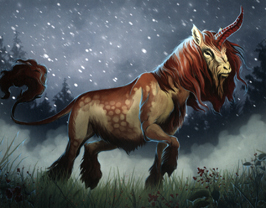 Glade unicorns, also known as spring unicorns and gladeicorns, are servants of both Eostre and Kenaz. Their horn radiates powerful magic, which keeps the temperatures around their domains above freezing. Naturally, this power is considered an abomination by servants of Thrym, who have waged a war of extinction against these noble, gentle beasts.
Glade unicorns, also known as spring unicorns and gladeicorns, are servants of both Eostre and Kenaz. Their horn radiates powerful magic, which keeps the temperatures around their domains above freezing. Naturally, this power is considered an abomination by servants of Thrym, who have waged a war of extinction against these noble, gentle beasts.
Glade unicorns are tan-colored, with a single flame-red horn. Their horn loses all power when the unicorn dies. They are wary of most creatures except hearth elves. (Taiga elves don't like them, as the temperatures in their glade are uncomfortable for the cold-loving taiga dwellers.)
|
|
|
|
|
May 27, 2017
Monstrous Compendium Al-Qadim Appendix
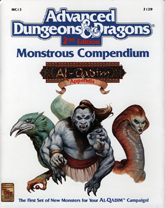 design: Wolfgang Baur & Steve Kurtz
design: Wolfgang Baur & Steve Kurtz
interior artists: Thomas Baxa & Mark Nelson
cover artist: Jeff Easley
publisher: TSR
publication date: 1992
cover: loose pages in folder
number of pages: 68
ISBN: 978-1560-763703
description: This compendium contains creatures intended for the Middle-Eastern themed campaign setting, Al-Qadim. The book is compatible with Advanced Dungeons and Dragons second edition.
Our featured entry from this bestiary is the artist-tasked genie.
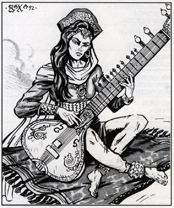 Tasked artist genies include both incredibly skilled craftsmen and aesthetically brilliant artists in fields widely accepted as high art. Both groups are capable of producing masterworks in their chosen speciality in a very short period of time. Reshaped from dao and djinn long ago, they will willingly serve a generous master, though they always undertake work they enjoy before doing work that they must do. Tasked artist genies are poets, composers, musicians, sculptors, painters, and weavers. The craftsmen genies (who bitterly deny that their work is any less artistic than that of the pure artists) are potters, woodworkers, furniture makers, silversmiths, goldsmiths, decorative ironmongers, gemcutters, jade and ivory carvers, calligraphers, illuminators, gardeners, maskmakers, tailors, haberdashers, and seamstresses.
Tasked artist genies include both incredibly skilled craftsmen and aesthetically brilliant artists in fields widely accepted as high art. Both groups are capable of producing masterworks in their chosen speciality in a very short period of time. Reshaped from dao and djinn long ago, they will willingly serve a generous master, though they always undertake work they enjoy before doing work that they must do. Tasked artist genies are poets, composers, musicians, sculptors, painters, and weavers. The craftsmen genies (who bitterly deny that their work is any less artistic than that of the pure artists) are potters, woodworkers, furniture makers, silversmiths, goldsmiths, decorative ironmongers, gemcutters, jade and ivory carvers, calligraphers, illuminators, gardeners, maskmakers, tailors, haberdashers, and seamstresses.
Mistreated artist genies will never produce superior work, though they have too much devotion to their craft to deliberately flaw a work (unless they are consistently abused with no hope of escape). Regardless of how hard they try, works produced by enslaved or charmed artist genies are never quite as good as those they make when they are free to pursue their work as they choose.
Of all the tasked genies, artist genies vary the most in their appearance, perhaps because the work they do varies so much. Sculptors have powerful shoulders from handling and hammering stone, weavers have powerful arms and quick fingers for throwing a shuttle across a loom, and painters may be quite frail but have a sharp eye for details and decoration. The craftsmen genies all have nimble fingers and a good sense of proportion.
In their dress, artist genies either push the boundaries of the latest design and daring or wear the most shabby and dated clothing imaginable. The pure artists are entirely hedonistic, though this is manifested in various ways. Some artist genies require odd foods, such as stewed apples or fermented fish while others must have parks and scenic vistas to stroll along each day for relaxation and contemplation before their work will achieve its highest level. Others still wallow in drink or gluttony, constant hot scented baths, or exotic companionship.
Slighting the work of an artist genie demands retribution, but this revenge can take many forms. A skilled critique by a knowledgable patron may earn only some vicious gossip in return. In the case of uninformed criticism by a pretender to knowledge, some artist genies are unstable enough to simply hurl themselves at their detractor, regardless of the consequences. Others are wise enough to enjoy more subtle forms of revenge (for example, creating a work that ridicules the offending party). Sometimes revenge takes the form of a gift that is given to some rival of the tactless speaker, or a mysterious increase in the cost of producing new work for a patron. Some forms of revenge are fatal, such as a potter genie adding enough poison to a clay vessel to slowly kill anyone who eats or drinks from it.
|
|
|
|
|
June 3, 2017
Monstrous Compendium Kara-Tur Appendix
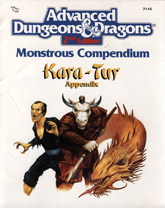 designer: Rick Swan
designer: Rick Swan
interior artists: Thomas Baxa
cover artist: Jeff Easley
publisher: TSR
publication date: 1990
cover: loose pages in folder
number of pages: 68
ISBN: 978-0880-388511
description: This compendium contains creatures intended for the East Asian themed campaign setting, Kara-Tur. The book is compatible with Advanced Dungeons and Dragons second edition.
Our featured entry from this bestiary is the oni.
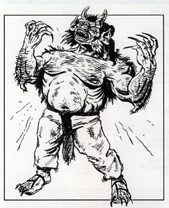 Oni are ferocious lesser spirits who use their awesome strength and magical abilities to dominate and terrorize the regions they inhabit.
Oni are ferocious lesser spirits who use their awesome strength and magical abilities to dominate and terrorize the regions they inhabit.
The common oni stands 7 to 8 feet tall, resembling a thickly muscled humanoid whose arms and legs are covered with coarse hair. Their hands end in dirty, thick talons, and hooked toenails grow from their wide feet. Their skin is normally red, but other colors have been noted, including green, black, orange, and purple. Blue-skinned oni also exist, but these are more commonly known as ogre magi, because they have as much in common with the western ogre as they do they with eastern oni.
The features of the common oni are fearsome to behold. They have from one to three bulging eyes and broad, pointed ears. One or two thick horns may sprout from their foreheads. Many oni wear shoulder-length hair--usually silver, black, or green--which sometimes is tied in long braids that drape down their backs. Long golden or ivory fangs line their mouths.
An oni's garb imitates the clothing of the local human population. If an oni band dwells near a military outpost, the lesser spirits usually wear armor pieces, including metallic arm and leg bands and even military insignia that have been taken from murdered soldiers. If an oni band lives near a poor farming community, they usually don peasant smocks and sandals. In any case, an oni's equipment and clothing is always more ragged and filthy than that of his human counterpart...
Combat: Most common oni are bloodthirsty and cruel. Not only do they attack for food, but also for the sheer delight of hurting and bullying other creatures. The common oni usually fights with a pair of two-handed swords, one in each hand, but the creature will use other large weapons if available. It also can make slashing attacks with its powerful claws...
Oni usually dwell in desolate and forbidding places, such as rocky mountain regions, deserted ruins, and other sites commonly considered to be haunted. They also may take up residence along a lonely highway near a shrine or gate, harassing all who pass by. Occasionally, an oni may live within a city, hiding in vacant buildings or in the shadows of the city's most destitute streets.
|
|
|
|
|
June 10, 2017
Monstrous Compendium Mystara Appendix
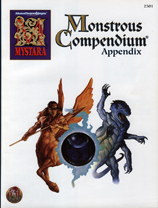 authors: John Nephew, John Terra, Skip Williams & Teeuwynn Woodruff
authors: John Nephew, John Terra, Skip Williams & Teeuwynn Woodruff
interior artists: Arnie Swekel
cover artist: Jeff Easley
publisher: TSR
publication date: 1994
cover: softcover
number of pages: 128
ISBN: 978-1560-768753
description: This compendium contains creatures intended for the Mystara campaign setting. The book is compatible with Advanced Dungeons and Dragons second edition.
Our featured entry from this bestiary is the gray philosopher.
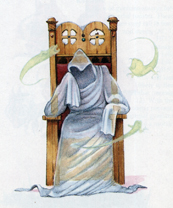 A gray philosopher is the undead spirit of an evil cleric who died with some important philosophical deliberation yet unresolved in his or her mind. In its undead state, this creature does nothing but ponder these weighty matters.
A gray philosopher is the undead spirit of an evil cleric who died with some important philosophical deliberation yet unresolved in his or her mind. In its undead state, this creature does nothing but ponder these weighty matters.
The gray philosopher appears as a seated, smoke-colored, insubstantial figure swathed in robes. It always seems deep in thought. Flying through the air surrounding the philosopher are a number of tiny, luminous, wispy creatures known as malices. They have vaguely human faces, gaping maws, and spindly, clawed hands. These vindictive creatures are actually the philosopher's evil thoughts, which have taken on substance and a will of their own...
Habitat/Society: A gray philosopher never seems able to reach any sort of conclusion to the conundrum that has become the focus of its existence; instead, over the centuries, its evil thoughts have coalesced into the malices. A philosopher typically creates 2d4 malices for every century of its foul existence. It is unknown whether the philosopher is even aware of these venal children of its mind...
Ecology: Certain clerics and academicians speculate that any powerful evil cleric who, at death, becomes a gray philosopher may have been attempting to become one of the Immortals. Such sages theorize that a few of the creatures do manage to resolve the philosophical dilemmas upon which they ponder, which leads them to transcend their mortality finally to become profoundly evil and immortal beings. Although these theories propose that it takes a gray philosopher at least 1,000 years to reach such a terrible understanding, the sages urge those who discover these undead creatures to destroy them immediately, in case this frightening theory has merit.
|
|
|
|
|
June 17, 2017
The Collected Monsters of Sin
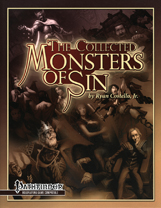 author: Ryan Costello, Jr.
author: Ryan Costello, Jr.
interior artists: Aaron J. Riley & Cory Trego-Erdner
cover artist: Cory Trego-Erdner
publisher: Kobold Press
publication date: 2013
cover: softcover
number of pages: 60
ISBN: 978-1936-781225
description: This bestiary contains four creatures associated with each of the seven cardinal sins. The book is compatible with the Pathfinder Role Playing Game.
Our featured entry from this bestiary is a monster of gluttony, the bottomless pit.
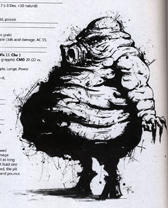 The obese mass sits nearly comatose. At the first sign of a living creature it perks up, licking its lips from snout to navel.
The obese mass sits nearly comatose. At the first sign of a living creature it perks up, licking its lips from snout to navel.
Erupting Metabolism A bottomless pit digests its meals fast enough to keep its ungainly body moving even after swallowing its own weight in prey. Swallowed creatures take 3d6 acid damage every round until dead, and as long as the bottomless pit has at least one still-living creature swallowed, the pit gains the benefits of haste and pounce.
Sectioned Stomach A bottomless pit's stomach branches into numerous smaller chambers, allowing it to contain and digest multiple creatures simultaneously. A bottomless pit can swallow creatures up to its own size category, and can have multiple creatures swallowed at once: up to two Medium creatures, four Small, eight Tiny, or any equivalent combination. If a swallowed creature cuts its way out of the bottomless pit, the appropriate fraction of its stomachs are unusable until its damage is healed, but the rest of its stomachs function normally.
Between feedings a bottomless pit is a sluggish, misshapen creature. Two stubby bowed legs quiver to support its weight. Its flat, earless head ends in a snout. A roll of flesh suggests where a bottomless pit's head separates from its torso, but this is an illusion: Its cantilevered jaw hinges off its hip bones, and when its mouth is open, it extends out the length of its torso, stretching the loose flesh of its jowls taut.
A bottomless pit is most dangerous immediately after it feeds. At that time it virtually explodes with energy, and once it achieves that state it works to maintain it by eating more and more. A pit eats every living creature in sight, and doesn't stop until it runs out of prey. Bottomless pits can sit inert for months between meals, shedding almost no weight and suffering no negative effects from such fasting.
A typical bottomless pit weighs 750 pounds and stands five and a half feet tall.
|
|
|
|
|
June 24, 2017
Monstrous Compendium Greyhawk Adventures Appendix
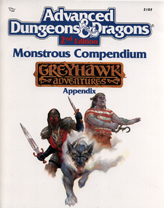 designers: Grant Boucher, William W. Connors, Steve Gilbert, Bruce Nesmith, Chris Mortika, and Skip Williams
designers: Grant Boucher, William W. Connors, Steve Gilbert, Bruce Nesmith, Chris Mortika, and Skip Williams
interior artists: Thomas Baxa and Mark Nelson
cover artist: Jeff Easley
publisher: TSR
publication date: 1990
cover: loose pages in folder
number of pages: 68
ISBN: 978-0-88038-836-8
description: This compendium contains creatures found in the Greyhawk Campaign Setting. The book is compatible with Advanced Dungeons and Dragons second edition.
Our featured entry from this bestiary is the skulk.
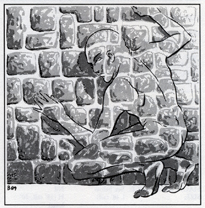 Skulks are an extremely cowardly, evil race of humanoids with the chameleon-like ability to blend in with any background. They survive on the edges of civilization by theft and murder.
Skulks are an extremely cowardly, evil race of humanoids with the chameleon-like ability to blend in with any background. They survive on the edges of civilization by theft and murder.
Skulks stand five to six feet tall and are completely devoid of hair. They are elf-like in stature, with graceful limbs, soft facial features, and pink or blue eyes. A skulk's skin is smooth but leathery tough. Its natural color is light gray, but skulks can change skin color instantly, either to flesh tone or, more commonly, to match the surrounding environment.
Skulks speak common and 20% of skulks speak one additional demihuman language, usually elvish or dwarf.
Combat: Skulks are cowardly fighters who run away at first wounding or if the odds are less than two to one in their favor whichever comes first...
Habitat/Society: Skulks survive by thievery and murder. They live in small bands, moving often, and camping in deep forests or underground lairs. They hide by day, but emerge at night to raid nearby human or demihuman communities. Their favorite tactic is to murder an entire family, then ransack the house at their leisure...
Ecology: Skulks eat whatever they find in the pantry of their victims. In hard times, skulks steal livestock, leaving a hole in the fence so it appears the animal escaped accidentally.
In addition to food, skulks steal whatever strikes their fancy. Female skulks often take gold, jewelry, and fine cloths. Male skulks are apt to lug furniture back to their camp. Disputes over property are common but infighting is rare. Instead, skulks steal from one another at the first opportunity...
|
|
|
|
|
July 1, 2017
Monstrous Compendium Forgotten Realms Appendix I
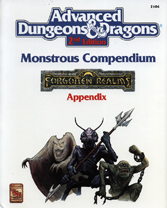 design concept: David "Zeb" Cook, Steve Winter and Jon Pickens
designers: William Connors, David Martin, Rick Swan and Gary Thomas
design concept: David "Zeb" Cook, Steve Winter and Jon Pickens
designers: William Connors, David Martin, Rick Swan and Gary Thomas
interior artists: Thomas Baxa & Mark Nelson
cover artist: Jeff Easley
publisher: TSR
publication date: 1989
cover: loose pages in folder
number of pages: 68
ISBN: 978-0-88038-769-9
description: This compendium contains creatures found in the Forgotten Realms Campaign Setting. The book is compatible with Advanced Dungeons and Dragons second edition.
Our featured entry from this bestiary is the thylacine.
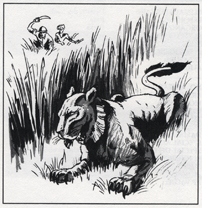 The thylacine, also known as the jumping tiger or mantiger, is a fearless predator that possesses illusionary powers.
The thylacine, also known as the jumping tiger or mantiger, is a fearless predator that possesses illusionary powers.
It is similar in size and shape to a normal tiger. The fur is a smudgy, smoky-gray with irregular patches of varying hues. The eyes are black. This cat possess infravision (120-yard range). Its acute senses of hearing and smell enable it to track with 80% efficiency...
Habitat/Society: The thylacine dwells in rocky areas and deep forests. It is a solitary hunger. It does not maintain a lair, although it may have several favored rest spots. High, rocky ledges and small, concealed caves are its first choice; it will make do with tangled thickets and ruins. The beast hides the remains of its meals. Although it does not collect treasure, it sometimes uses such items as bait to lure humanoids into a trap...
Ecology: Thylacines may make alliances with other intelligent felines or feline monsters when dealing with a common problem or foe. They are closes in temperament to weretigers and may share territories with such beings. They detest canine and lupine species and monsters.
|
|
|
|
|
July 8, 2017
Monstrous Compendium Forgotten Realms Appendix II
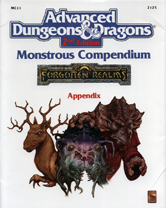 designers: David "Zeb" Cook (coordinator), Tim Beach, Tim Brown, William W. Connors, Dale Donovan, Ed Greenwood, Jeff Grubb, Bruce Heard, Slade Henson, Rob King, Colin McComb, Roger E. Moore, Bruce Nesmith, Jon Pickens, Jean Rabe, Dori Watry, Skip Williams, and probably a few other fine people we've forgotten...
designers: David "Zeb" Cook (coordinator), Tim Beach, Tim Brown, William W. Connors, Dale Donovan, Ed Greenwood, Jeff Grubb, Bruce Heard, Slade Henson, Rob King, Colin McComb, Roger E. Moore, Bruce Nesmith, Jon Pickens, Jean Rabe, Dori Watry, Skip Williams, and probably a few other fine people we've forgotten...
interior artists: Tom Baxa, Valerie Valusek and Mark Nelson
cover artist: Jeff Easley
publisher: TSR
publication date: 1991
cover: loose pages in folder
number of pages: 68
ISBN: 978-1-56076-111-2
description: This compendium contains creatures found in the Forgotten Realms Campaign Setting. The book is compatible with Advanced Dungeons and Dragons second edition.
Our featured entry from this bestiary is the harrla.
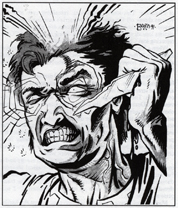 Every culture has reports of unusual behavior by otherwise normal people. Perhaps a wife who has been true and faithful for many years suddenly seeks passion in the arms of a stranger. Maybe a man who has been good and kind his entire life suddenly lashes out and kills several of his best friends. Sometimes this sudden change is the result of natural psychological stress or madness, but often it is the work of the dreaded harrla.
Every culture has reports of unusual behavior by otherwise normal people. Perhaps a wife who has been true and faithful for many years suddenly seeks passion in the arms of a stranger. Maybe a man who has been good and kind his entire life suddenly lashes out and kills several of his best friends. Sometimes this sudden change is the result of natural psychological stress or madness, but often it is the work of the dreaded harrla.
The harrla is naturally and permanently invisible. Those capable of sensing invisible objects see it as a humanoid figure, the height of a man. Its edges shimmer and fluctuate, making it impossible to determine if the form is a man or a woman.
The harrla has no known language, and seems unable to communicate. Some scholars say that a harrla can communicate with others of its kind, but there is certainly no proof of this. As they are almost never encountered in pairs or groups, however, language is all but unnecessary for them.
Combat: The harrla does not enter physical combat the way that many creatures do. It has no capacity to inflict physical damage and takes whatever steps it must to avoid placing itself in danger of physical or mystical assault. Of course, it is aware that most material weapons and spells cannot harm it, so its judgment is
affected by these considerations. The main "attack" mode of the harrla is its ability to infuse a living creature with an overpowering emotion. Each harrla is able to project only a single emotion. Although there are, in theory,
as many types of harrla as there are emotional states, some common examples include hate, passion, and fear.
Hate: This type of harrla is capable of inducing hate in its victims that causes them to be overwhelmed with the desire to kill and destroy. While they do not simply attack anyone that they see, the slightest provocation results in a violent outburst. Thus, someone at the breakfast table might go into a killing frenzy upon finding that his meal was improperly prepared.
Passion: Those infused with passion find themselves unable to control their romantic desires. They fall into the arms of the nearest person of the appropriate sex and behave in a most wanton manner. The effects of this infusion are similar to those of the philter of love, only more intense and of shorter duration.
Fear: Persons overcome with fear flee from anything that presents itself to them in a frightening manner. Because the victims lose control of basic common sense, however, even persons reaching out to or walking toward the characters will take on menacing overtones.
The harrla is naturally drawn to those who are struggling to keep the emotion that it generates in check. Once it finds such persons, it begins to stimulate the emotional centers of the victims' subconscious minds. Within a few seconds, the victims become consumed by the false emotions of the harrla and act purely according to their new emotional state...
The victims have no memory of what they have done while under the influence of the harrla and are often shocked to learn what has transpired during the missing minutes of their life...
Habitat/Society: The harrla is a strange and solitary creature. It has no social organization, but drifts like a hunting shark through the sea of humanity in search of a victim. When it finds a target, it strikes.
Harrla seem to develop some sort of psychological attachment to their victims. They become fascinated with the character's ability to "feel" and the intensity of its emotions. They tend to linger near past victims, waiting for a chance to dominate them again...
While the harrla is indeed a dangerous adversary, it is not without weaknesses. Experience has shown that each and every harrla has a special weakness related to the emotion that it projects. For example, one scholar, a noted authority on paranormal creatures, reports that he once encountered a harrla that induced an utterly consuming depression in its victims. This despair was so great as to be life threatening. Upon researching the local rumors, he found ancient writings that convinced him that the tears of one of its victims would be damaging to the harrla. Sure enough, when the sage sprinkled such tears upon the harrla, it let out an audible shriek of agony and fled the area, never to be "seen" again.
Ecology: The harrla seems to be a natural creature. While some speculate that it is undead or of extraplanar origin, there seems to be little proof of this. Most sages agree that the harrla is not a product of the negative material plane, as most undead are. It appears to be a natural creature that stalks mankind in much the same way that wolves might hunt sheep who have wandered from the flock.
Although little is understood about the harrla's need for emotional energy, several theories have been put forth to account for the creature's behavior. Perhaps the most convincing of these is that the harrla stimulates emotions in others because it lacks them itself. According to this school of thought, the harrla's soul is barren and without happiness. In order to experience the joys of emotion, such as the warm touch of a lover's kiss, the stimulating fury of an angry rage, or the vibrant excitement of terror, the creature must make use of proxies.
If true, this theory explains much, including the creature's apparent attraction to those who do not normally display the emotion that it stimulates, for it desires to share the thrill of these emotions with those who also, in its mind, lack them. Whether this is true or not, only further studies of the creature's tragic influence will tell.
|
|
|
|
|
July 15, 2017
13th Age Bestiary
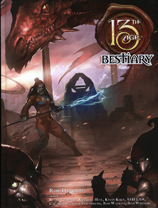 author: Rob Heinsoo et al.
author: Rob Heinsoo et al.
interior artist: Rich Longmore
cover artist: Pascal Quidault
publisher: Fire Opal Media & Pelgrane Press
publication date: 2014
cover: hardback
number of pages: 240
ISBN: 978-1908-983572
description: This bestiary contains some all new creatures and ports other favorites to the system. The book is compatible with the 13th Age Role Playing Game.
Our featured entry from this bestiary is a fungaloid, the twygzog.
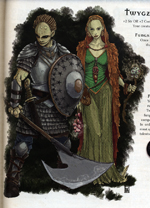 Fungaloids are a single species but come in many varieties. When a fungal kingdom appears the fungi form into the shapes needed to fulfill the functions of the kingdom. There are slow farmer fungi, fast warrior fungi, huge guardian fungi, non-sentient fungi, and of course, the intelligent fungaloid monarchs who rule their dark kingdoms. Fungal kingdoms are found all over the world, in the most unusual places. There are several theories for why that might be...
Fungaloids are a single species but come in many varieties. When a fungal kingdom appears the fungi form into the shapes needed to fulfill the functions of the kingdom. There are slow farmer fungi, fast warrior fungi, huge guardian fungi, non-sentient fungi, and of course, the intelligent fungaloid monarchs who rule their dark kingdoms. Fungal kingdoms are found all over the world, in the most unusual places. There are several theories for why that might be...
- They are the remnants of a prehistoric civilization. While their living fungus cities and devices have perished, a remnant of the civilization lives on. They are fading, the last creatures from a time before vertebrates walked the world.
- They appear everywhere because they sporate, and their spores eventually find a fertile environment. They have a diffuse underground kingdom in the deep reaches of the underworld and communicate over vast distances through mycotic threads that run through the rock itself.
- They are a mighty civilization that is alien to other cultures, with motivations unknowable to non-fungaloid life. They have perfect racial memory, and due to serial reincarnation, operate on long geologic time scales. The rise and fall of mighty empires is nothing to them, a mere blink of time to those that are truly undying.
Fungal kingdoms occasionally develop fungaloids that are able to cooperate and interact with other races as equals. Such creatures are called twygzogs (twig-zos), which roughly translated to "noble" or "prince" (though outsiders often just called them "Zogs"). Twygzogs are very rare, perhaps because they are such freaks--they have lost the pure connection with fungal overmind that characterizes other fungaloids, but gained free will.
Twygzogs resemble surface races, but are bald and pale and have fungal gills where their hair should be. They have the uncanny ability to shift their flesh to resemble others, though their mushroom complexions and huge pale eyes mean they can't pass for a member of another race without an additional disguise or magic. Twygzogs don't sleep, but they do need to rest from physical exertion for at least six hours a day (four hours if in damp loamy soil, or eight hours if in a harsh environment).
|
|
|
|
|
July 22, 2017
Monstrous Compendium Ravenloft Appendix I
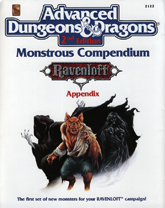 designer: William W. Connors
designer: William W. Connors
interior artist: Thomas Baxa
cover artist: Jeff Easley
publisher: TSR
publication date: 1991
cover: loose pages in folder
number of pages: 68
ISBN: 978-1-56076-108-2
description: This compendium contains creatures found in the gothic Ravenloft Campaign Setting. The book is compatible with Advanced Dungeons and Dragons second edition.
Our featured entry from this bestiary is the red widow.
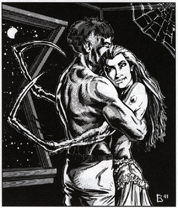 The red widow, or spider queen, is an evil and deadly shape changer. Spinning a web of evil to all the lands about it lair, this foul creature derives a vile pleasure in the murder of those lured to it by its many charms and promises of delight.
The red widow, or spider queen, is an evil and deadly shape changer. Spinning a web of evil to all the lands about it lair, this foul creature derives a vile pleasure in the murder of those lured to it by its many charms and promises of delight.
The red widow has two physical forms. The first, and that in which it is most commonly encountered, is a human one. In this guise, the red widow appears as a fantastically beautiful and alluring woman with long, flowing red hair. The creature's dress will vary to enable it to blend in with the human society around it, but will always be provocative and inviting...
The red widow will adopt its true form, that of a giant spider, only when it is about to make a kill. In this shape, the creature has a bright crimson body with a black, hourglass pattern on its back. In effect, it looks like a giant version of the common black widow, save that the colors are reversed.
Combat: Red widows seldom engage in open combat. Rather, they lure unsuspecting victims near and draw them into a passionate embrace. Once this is done, they transform into their true form. Those who witness this change (usually only the doomed victim) must make an immediate horror check. The transformation into a giant spider takes a full round, during which the creature never releases its hold on its victim...
Habitat/Society: The red widow often makes its home in the cities and towns of men. Here, it moves about in its human guise and seduces its victims under cover of darkness. It is not uncommon for a red widow to love and then destroy a new victim every week.
Ecology: Red widows live by draining the blood and other bodily fluids from those they kill. A slain lover is hidden away somewhere in the creature's lair and can supply the widow with nourishment from up to a week. When the monster finishes with a corpse, it discards the partially decomposed and dehydrated body far from its lair. In this way, it hopes that its home will escape detection.
|
|
|
|
|
July 29, 2017
Monstrous Compendium Ravenloft Appendix II: Children of the Night
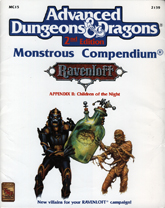 designer: William W. Connors
designer: William W. Connors
interior artist: Mark Nelson
cover artist: Jeff Easley
publisher: TSR
publication date: 1993
cover: loose pages in folder
number of pages: 68
ISBN: 978-1-56076-586-8
description: This compendium contains creatures found in the gothic Ravenloft Campaign Setting. The book is compatible with Advanced Dungeons and Dragons second edition.
Our featured entry from this bestiary is the medusa, Althea.
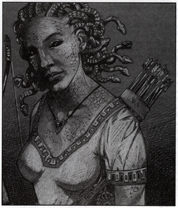 Northwest of the domain of Lamordia, beyond even the terrible Isle of Agony, lies a small island known only as Demise. Those who pass near the island have reported hearing songs of great beauty drifting out across the waves. Sailors who travel to this island seldom return, however, for the only thing to be found of the island of Demise is death at the hands of Althea.
Northwest of the domain of Lamordia, beyond even the terrible Isle of Agony, lies a small island known only as Demise. Those who pass near the island have reported hearing songs of great beauty drifting out across the waves. Sailors who travel to this island seldom return, however, for the only thing to be found of the island of Demise is death at the hands of Althea.
Althea is a medusa, one of that terrible race of women who sport tresses of deadly vipers instead of hair atop their heads. Like all her kind, Althea's body is that of a slender, even shapely human woman. Her countenance,
however, is dreadful, having the general features of a human face but possessing the scales and texture of a
reptile. Her eyes are nothing more than black beads, her mouth but a lipless slit through which her forked
tongue slips in and out to taste the air for odors...
It is impossible to say with certainty which languages Althea does or does not know. While she seems to know the language of Lamordia, she speaks it with a pronounced accent. What her home language is, or where she might have originated, is unknown.
Combat: Althea's primary weapon is, of course, her petrification attack. Anyone who looks into her snakelike eyes is instantly transformed to stone unless he or she can make a Saving Throw vs. Petrification. This attack can affect a single enemy per round and has a maximum range of 30 feet.
The power of Althea's gaze is so great that it extends even into the Astral and Ethereal planes. Indeed, she is
able to see creatures moving about in these nether regions as plainly as she sees those on the Prime Material Plane...
The snakes atop her head are able to attack each round. Althea's asps can bite for a single point of damage,
but anyone bitten must make a Saving Throw vs. Poison or die instantly.
Habitat/Society: Demise, the island on which Althea lives, is far from hospitable. Indeed, it is little more than a great outcropping of rock amid the grey-blue expanse of the Sea of Sorrows. Those who approach by sea will find no safe anchorage near the rocky cliffs that pass for Demise's shore. A small boat might reach the coast safely, but only the most experienced seaman would stand much chance of surviving such an attempt...
Ecology: The island on which Althea lives is indeed a wonder of nature. From the sea, it looks like a cone of rough black stone rising out of the waves. Newly landed mariners will find its shores bleak and desolate.
Ascending the cone, however, will bring one to the lip of a great caldera. Looking down into this crater will reveal a thriving jungle of plants, hot springs, and rolling banks of steam. Exploration of the jungle will undoubtedly lead to the discovery of the labyrinth at its heart. The lack of animals larger than insects is further proof of this place's unnatural history...
|
|
|
|
|
August 5, 2017
Monstrous Compendium Ravenloft Appendix III: Creatures of Darkness
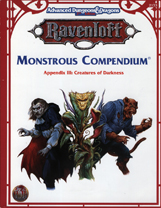 designers: Kirk Botulla, Shane Hensley, Nicky Rea & Teeuwynn Woodruff
designers: Kirk Botulla, Shane Hensley, Nicky Rea & Teeuwynn Woodruff
interior artist: Mark Nelson et al.
cover artist: Jeff Easley
publisher: TSR
publication date: 1994
cover: softcover
number of pages: 128
ISBN: 978-1-56076-914-9
description: This compendium contains creatures found in the gothic Ravenloft Campaign Setting. The book is compatible with Advanced Dungeons and Dragons second edition.
Our featured entry from this bestiary is the shadow virus.
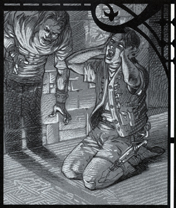 A character contracts this infection through physical contact with the dormant virus, just as with other strains. However, it is the victim's shadow which the virus first attacks, causing it to rot away. A victim whose shadow is destroyed by the virus becomes a shadow himself.
A character contracts this infection through physical contact with the dormant virus, just as with other strains. However, it is the victim's shadow which the virus first attacks, causing it to rot away. A victim whose shadow is destroyed by the virus becomes a shadow himself.
The initial symptoms of this horrifying virus are deceptively mild: simply a slight tingling of the scalp and a low fever. At the end of the first day of infection, however, the victim's shadow shows distinct signs of fraying around the edges. As the days pass, the victim's shadow continues to unravel and, if the virus is not halted, disappears entirely on the seventh day. Once the host's shadow has been consumed by the virus, the infection begins to take its toll on the flesh of the body. Within a day, one of the victim's limbs grows insubstantial, and on each successive another portion of the victim's body becomes shadowy. On the fourteenth night of infection, the victim fades away utterly and dies. Within minutes of his demise, the character rises as a shadow himself.
A psionicist with the shadow form science cannot use this ability while infected with the virus. If a continual light spell is placed upon a small blessed diamond and the victim swallows this stone within the first seven days of the infection, he is cured. The reaction of the virus to the gem destroys them both, so the diamond is lost.
Shadows created by this virus carry the disease with them, so anyone touched by a virulent shadow risks contamination. Unlike the other viruses, this one is not spread by living carriers.
|
|
|
|
|
August 12, 2017
Aventyr Bestiary
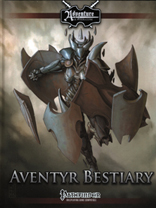 lead developers: Mike Myler & Jonathan G. Nelson
lead developers: Mike Myler & Jonathan G. Nelson
interior artist: Bruno Balixa et al.
cover artist: Raven Mimura
publisher: AdventureAWeek.com Games
publication date: 2015
cover: hardcover
number of pages: 144
ISBN: 237-0007-290116
description: This tome of monsters is drawn from scores of Adventureaweek.com adventures and the associated blog. The book is compatible with the Pathfinder RPG.
Our featured entry from this bestiary is the book golem.
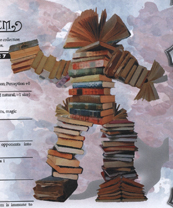 A book golem is a construct with no free will of its own, designed and made for a specific purpose, only able to follow the orders given to it at the time of its creation (outside of a few simple commands from the person it has been bonded to obey). It has no possessions and no weapons. Book golems cannot speak, although they can emit an unsettling whisper with their pages; they move stiffly, as if not in complete control of their bodies.
A book golem is a construct with no free will of its own, designed and made for a specific purpose, only able to follow the orders given to it at the time of its creation (outside of a few simple commands from the person it has been bonded to obey). It has no possessions and no weapons. Book golems cannot speak, although they can emit an unsettling whisper with their pages; they move stiffly, as if not in complete control of their bodies.
Although most book golems are mindless there are persistent rumors of some that gain the collected knowledge printed upon the many pages comprising their body. Certainly most who construct book golems prefer mindless slaves over free-willed creations, and as a result intelligent book golems are a barely explored concept, treated as fanciful stories from old wizards.
A book golem stands 8 feet tall and weighs 500 pounds.
Construction: Comprised of various tomes stacked into the shape of a humanoid, a book golem requires no less than four tomes per limb (along with unguents and bindings worth 500 gp). Any book can be used, although several wizards have found that crafting tomes of knowledge and learning seems to grant the golem a sense of cunning and personality (and just as many have discredited that as wishful thinking). Several attempts to create a book golem with access to the spells contained within tomes bound into its body have thus far proved unsuccessful.
|
|
|
|
|
August 19, 2017
Monstrous Compendium Dark Sun Appendix: Terrors of the Desert
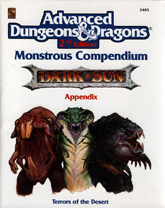 designers: Tom Prusa, Louis J. Prosperi, Walter M. Bass & Kira Glass
designers: Tom Prusa, Louis J. Prosperi, Walter M. Bass & Kira Glass
interior artists: Tom Baxa & Mark Nelson
cover artist: Jeff Easley
publisher: TSR
publication date: 1992
cover: loose pages in folder
number of pages: 68
ISBN: 978-1-56076-272-0
description: This compendium contains creatures found in the Dark Sun Campaign Setting. The book is compatible with Advanced Dungeons and Dragons second edition.
Our featured entry from this bestiary is the mul.
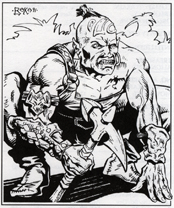 Muls are a cross-breed of dwarf and human that are raised for the gladiatorial games often played on Athas. While all are born into captivity, some escape and make their homes in the plains and oasis of the Athasian deserts.
Muls are a cross-breed of dwarf and human that are raised for the gladiatorial games often played on Athas. While all are born into captivity, some escape and make their homes in the plains and oasis of the Athasian deserts.
Muls are stout humanoids, averaging 6 to 6½ feet tall, and weighing up to 300 pounds. While their height comes from their human side, muls also have strong, stocky bodies, an obvious trait from their dwarven parentage. Muls are light skinned, sometimes having a copperish skin coloration. Muls have a face that is undeniably human looking, though their ears are swept back and mildly pointed. All muls, both male and female, have no head or facial hair of any kind.
Combat: Wild muls will often end up in combat situations during the course of their life. Muls are commonly tracked by bounty hunters hired by the templars and noblemen who operate the gladiatorial games. When a wild mul engages in combat, they are most effective fighters...
Habitat/Society: Wild muls seldom form large groups, preferring to gather in small clans (ranging in size from two to seven members). These clans will often consist of muls who manage to escape together and remain together for mutual protection. Clans of wild muls usually settle in the rocky barren areas of Athas, near where the plains and the deserts of the Tablelands meet. With plant life being as scarce as it is, many muls have turned to animals, and even other humanoid races, as a source of food. This behavior causes most other races to greatly fear wild muls. This feeling is reciprocated by the muls, as they are particularly paranoid that any who find them are hunting them for the templars and noblemen of the gladiatorial games. Clans of muls are very unlikely to trust any who encounter them, except adventuring parties that have a mul among them. Even then, mul clans are overly suspicious, believing that they can trust no one.
All muls are born sterile, and no clans have offspring among them. The only time that young muls are found in the wild is when they escape with a group of adults. Since by definition, wild muls are escaped slaves, they very rarely enter cities once they have escaped. Any wild mul discovered within the walls of an Athasian city would be captured and, most likely, publicly executed as a discouragement to any muls who might consider escape in the future.
Ecology: Just as muls occasionally hunt and eat other humanoid races, they are hunted themselves. Some thri-kreen tribes hunt wild muls, which serves to foster an animosity between these two races.
|
|
|
|
|
August 26, 2017
Monstrous Compendium Dark Sun Appendix II: Terrors Beyond Tyr
 designers: Jim Atkiss, Steve Brown, Timothy B. Brown, Andrew P. Morris, Bruce Nesmith, Wes Nicholson & Bill Slavicsek
designers: Jim Atkiss, Steve Brown, Timothy B. Brown, Andrew P. Morris, Bruce Nesmith, Wes Nicholson & Bill Slavicsek
interior artist: Thomas Baxa
cover artist: Jeff Easley
publisher: TSR
publication date: 1995
cover: softcover
number of pages: 128
ISBN: 978-0786-900978
description: This compendium contains creatures found in the Dark Sun Campaign Setting. The book is compatible with Advanced Dungeons and Dragons second edition.
Our featured entry from this bestiary is the Athasian halfling.
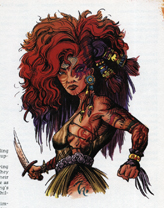 Throughout the Forest Ridge reside the multitude of halfling tribes. Though small, halflings are numerous enough to support their claim to this territory.
Throughout the Forest Ridge reside the multitude of halfling tribes. Though small, halflings are numerous enough to support their claim to this territory.
Halflings stand an average of 3 feet tall, rarely straying from their 50 to 60 pounds. Proportioned like humans, they are quick and muscular, possessing a strength that belies their size. The hair, eyes, and skin color of halflings tends to be as varied as their human counterparts. Regardless of a halfling's stage in maturity, their faces look like those of human children. The halfling language is comprised of a collection of mimicked animal sounds such as whistles, cawing, and chatter. Halflings can also speak the common tongue.
Combat: Strict carnivores, halflings tend to view all animals, including humans and their ilk, as lunch. Combat honor is a valueless concept to halflings. In battle, halflings resort to what others might call dirty tricks. Having strong ties to the land, halflings are likely to create their weapons from organic sources. A popular tenet among halfling warriors is that a weapon built from the same material as an opponent offers special advantages to the wielder. For example, a halfling jalath'gak slayer might construct a dagger from one of the bloodwing's talons...
Habitat/Society: Most halflings, except the chaotic and more brutal renegades near the Ringing Mountains, share a common outlook on life. This universal perception results in considerable racial unity despite geographical and political separations. It is rare that one halfing will shed the blood of another, even in extreme ideological confrontations.
Other races find halfing culture a difficult concept to understand. Ages of social and spiritual change from a plethora of inspirations have led to only one consistent conclusion--halflings value most the abilities of the inner self as it harmonizes with the environment and the halfling race. More common measurements, such as conquest and plundering. have no place with the halfling.
Ecology: Halflings are extremely conscious surrounding environment. They see the ruined land of the scapes and are sickened. They desperately try to avoid having similar circumstances devastate their homelands. This does not mean the countryside is unalterable, but simply that care must be taken to understand and respect what nature means to the life on Athas.
The halfling's meat-only diet means that halflings see all living creatures more as food than as equals. This perception leads them to expect other races to feel similarly. As a result, at no time is a halfling likely to trust any other member of any other species.
|
|
|
|
|
September 2, 2017
Querp Bestiary
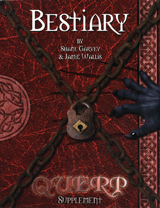 authors: Shane Barvey & Jamie Wallis
authors: Shane Barvey & Jamie Wallis
interior artist: Jamie Wallis et al.
cover artist: Jamie Wallis
publisher: Greywood Publishing/Cubicle 7 Entertainment Limited
publication date: 2011 (2nd edition)
cover: softcover
number of pages: 108
ISBN: 978-0-85744-064-8
description: This compendium contains the basic fantasy creatures for the QUERP (QUick and Easy Role-Playing) game.
Our featured entry from this bestiary is the Satyr.
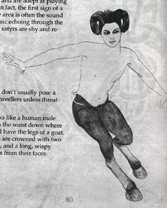 In the depths of the largest forests you can find many strange creatures, one of which is the satyr. Here they frolic, often with nymphs to whom the species has close relations. They are fond of good wine and drink it in copious amounts, which often means that they are drunk when encountered. They also love music and are adept at playing the pipes; in fact, the first sign of a satyr in the area is often the sound of pipe music echoing through the trees. Most satyrs are shy and reclusive and don't usually pose a danger to travelers unless threatened.
In the depths of the largest forests you can find many strange creatures, one of which is the satyr. Here they frolic, often with nymphs to whom the species has close relations. They are fond of good wine and drink it in copious amounts, which often means that they are drunk when encountered. They also love music and are adept at playing the pipes; in fact, the first sign of a satyr in the area is often the sound of pipe music echoing through the trees. Most satyrs are shy and reclusive and don't usually pose a danger to travelers unless threatened.
A satyr looks like a human male except from the waist down where they instead have legs of a goat. Their heads are crowned with two small horns, and a long, wispy beard grows from their faces.
|
|
|
|
|
September 9, 2017
Pathfinder Bestiary 6
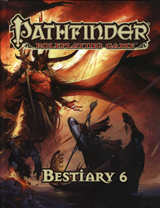 development lead: James Jacob
development lead: James Jacob
interior artists: Alexandur Alexandrov et al.
cover artist: Wayne Reynolds
publisher: Paizo Publishing
publication date: May, 2017
cover: hardcover
number of pages: 320
ISBN: 978-1601259318
description: This bestiary is the sixth general monstrous compendium associated with the Pathfinder Role Playing Game.
Our featured entry from this bestiary is the Qlippoth Lord, Oaur-Ooung.
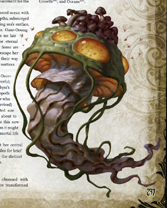 Immense Oaur-Ooung is a horrifically prolific source of soldiers for the qlippoth's war against mortals. It is from this qlippoth lord that a significant number of the Abyss's qlippoth hordes emerge. If through some chance event Oaur-Ooung were permanently slain, the production of qlippoth by the Abyss would not cease entirely, but it would diminish by a noticeable amount--at least, until the Abyss churned out some sort of equally vile and fecund replacement for the slain qlippoth lord.
Immense Oaur-Ooung is a horrifically prolific source of soldiers for the qlippoth's war against mortals. It is from this qlippoth lord that a significant number of the Abyss's qlippoth hordes emerge. If through some chance event Oaur-Ooung were permanently slain, the production of qlippoth by the Abyss would not cease entirely, but it would diminish by a noticeable amount--at least, until the Abyss churned out some sort of equally vile and fecund replacement for the slain qlippoth lord.
Oaur-Ooung's Abyssal sanctum is a poisoned ocean with no shoreline. Here and there in its inky depths, submerged mountaintops reach in vain for the churning sea's surface, and leviathans swim through the vastness. Oaur-Ooung is the largest among them, but she keeps no lair as her own, content to drift through the eternal ocean spawning qlippoth large and small. Some are drowned, some she consumes, but enough escape her clutches and the ocean's depths to make their way elsewhere into the Abyss, often via churning vortices to other realms.
Sometimes, the creatures born from Oaur-Ooung's blisterwombs are particularly powerful; it's rumored that at least one of the Abyss's demon lords began its existence as a qlippoth lord emerging from Oaur-Ooung. Those few who have recently seen Oaur-Ooung (and survived) claim that a blisterwomb of unprecedented size boils on her flank, suggesting that she is about to spawn something of immense power. What this new addition to the Abyss might be and what form it might take is unknown, but it surely bodes ill for mortal life on countless worlds.
Oaur-Ooung's body is 120 feet long, but her central tentacular stalk can unfurl to a length of miles for brief moments to lash out at creatures that have the distinct misfortune of having attracted her attention.
Oaur-Ooung's Cult
Worshipers of Oaur-Ooung tend to be obsessed with one thing: the overwhelming desire to be transformed into a qlippoth. These cultists are not to be pitied, for their desires are not born out of shame. They believe that the qlippoth will win, and that by securing early transformation into one of these destructive beings, they will live on in the world they know will eventually replace all of reality. That they will retain none of their mortal memories or personalities is no deterrent to these people, as long as they survive in some form while the rest of their kind do not. Many have already abandoned their racial identities, repudiating their original cultures and pursuing magical or surgical alteration. Oaur-Ooung is worshiped on desolate coastlines and within the ruins of wracked or sunken ships, and sacrifices to her are often subjected to vile fleshwarping rituals in which their bodies become unholy components for transformative rituals designed to "evolve" the faithful and consume worshipers' foes.
Oaur-Ooung's symbol is a jellyfish-shaped rune, and her favored weapon is the trident. This qlippoth lord grants access to the domains of Chaos, Evil, Plant, and Water, and to the subdomains of Decay, Fear, Growth, and Oceans.
|
|
|
|
|
September 16, 2017
Monstrous Compendium Spelljammer Appendix
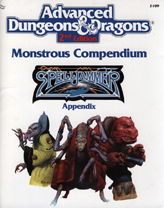 designer coordinator and noodger: Jeff Grub
designer coordinator and noodger: Jeff Grub
interior artists: Thomas Baxa & Mark Nelson
cover artist: Jeff Easley
publisher: TSR
publication date: 1990
cover: loose pages
number of pages: 68
ISBN: 978-0-88038-871-9
description: This compendium contains creatures found in the Spelljammer Campaign Setting. The book is compatible with Advanced Dungeons and Dragons second edition.
Our featured entry from this bestiary is the giant space hamster.
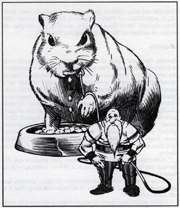 Giant space hamsters are exactly what they sound like--cut but brown-bear-sized rodents with thick fur. They are found on worlds having colonies of Krynnish gones (gnomoi and minoi). Giant space hamsters come in a variety of colors, but are usually golden brown with white underbellies, bands and spots. They are well muscled but appear fat. A giant space hamster can store up to 200 lbs. of food in its cheeks.
Giant space hamsters are exactly what they sound like--cut but brown-bear-sized rodents with thick fur. They are found on worlds having colonies of Krynnish gones (gnomoi and minoi). Giant space hamsters come in a variety of colors, but are usually golden brown with white underbellies, bands and spots. They are well muscled but appear fat. A giant space hamster can store up to 200 lbs. of food in its cheeks.
Combat: Giant space hamsters normally have only one mode of attack - a nasty bite. They avoid even this on most occasions, as domestic breeds are quite cowardly. However, wild breeds are more aggressive, and they briefly charge at anyone who approaches a burrow. Domesticated females profiting their litters also have improved morale (9). Careless gnome handlers have sometimes been bitten and (on a successful attack roll of 19 or better) stuffed into a cheek pouch, from which the gnome may escape if he rolls a successful Strength roll to open doors on a subsequent round. Trapped gnomes are merely covered in hamster spit, and are eventually spat out like old chewing gum when the hamster sees food.
Habitat/Society: A small pack of giant space hamsters consists of 1d4 adults (select the sexes by starting with a female and alternating thereafter, so a pack of three hamsters consists of two females and a male), with a 20% chance per adult female of 1d4 young being present (AC 10, MV 3, HD 1, #AT nil, Size S 3' long) and another 20% chance per adult female of 1d4 juveniles being present (AC 9, MV 6, HD 2, THAC0 19, #AT 1, Dmg 1d4, Size M 6' long). Gnomes are unable to figure out how to reduce their breeding rate, aside from separating the sexes (this conclusion was suggested after a 22-year-long research program that included five gnome fatalities). Giant space hamsters can easily have several litters in one year, and they grow to breeding adulthood in but two years. These creatures live 18 years at most, and remain fertile all their adult lives.
Ecology: Giant space hamster easily fill the niche occupied by large browsing animals, such as the elephant and the rhino on Earth, though most of them lack any real means of defending themselves. In the wild, they often die out despite their extraordinary reproductive rate. They are preyed upon by large- and medium-size carnivores, but they are immune to all parasites and diseases, magical or not. Cold weather forces them to hibernate for up to six months until the weather improves.
These creatures did not evolve naturally, as one might guess. They were created by a gnome research committee attempting to develop a relatively passive creature large enough to wind up the giant rubber bands attached to the huge running wheels inside gnomish spelljammer craft. These devices produce internal power from torque. (Teams of gnomes formerly filled this job.) The giant space hamsters produced by the committee ran for hours inside their big wheels, and were eventually spread through space.
Gnomes have found that the meat of giant space hamsters is quite tasty. Space hamster meat is called "spaham", and many gnomes eat large quantities of spaham with every meal. Many hamster ranches simply breed giant space hamsters as livestock.
Variations: Possibly the worst aspect of the giant space hamster (aside from its ludicrous existence) is that enchanted substances from numerous other sorts of nonhuman monsters can be introduced into its reproductive process, producing unbelievable (except to a gnome) new sorts of giant space hamsters. Some gnomish communities deliberately breed unique subspecies in competition with other communities to produce the most interesting varieties. Usually the results are more or less like the normal sort of giant space hamster, such as the wooly, mottled, ochre, Oriental, Occidental, chartreuse, spotted, non-quite-so-spotted, only-a-little-spotted, plaid, cave-dwelling, three-toed, lesser, greater, greater leesser, lesser greater, albino and flightless giant space hamsters...
|
|
|
|
|
September 23, 2017
Monstrous Compendium Spelljammer 2 Appendix
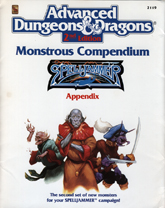 designers: Scott Davis, Newton Ewell & John Terra
designers: Scott Davis, Newton Ewell & John Terra
interior artists: Thomas Baxa and Mark Nelson
cover artist: Jeff Easley
publisher: TSR
publication date: 1991
cover: loose pages
number of pages: 68
ISBN: 978-1-56076-071-9
description: This compendium contains creatures found in the Spelljammer Campaign Setting. The book is compatible with Advanced Dungeons and Dragons second edition.
Our featured entry from this bestiary is the contemplator.
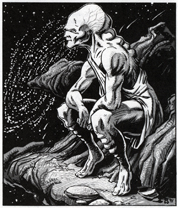 Contemplators live on barren asteroids, pondering the questions of the universe. Some say that when one discovers all the answers to all the questions the universe will end.
Contemplators live on barren asteroids, pondering the questions of the universe. Some say that when one discovers all the answers to all the questions the universe will end.
A contemplator is found most often seated in the classical thinker pose on a large stone outcropping. A gray humanoid, 12' tall, he often wears a gray toga. Consequently, unwary adventurers may easily mistake him for a statue.
Combat: A contemplator years for all knowledge and has deduced that the best way to gather it is directly from the minds of other beings. To gather information, he captures any intelligten being who lands on or comes near his asteroid.
The contemplator creates three arms out of the asteroid's surface to capture hsi specimens. Each arm can extend 50' and has 25 hit points. If an arm is destroyed, the contemplator can create another after 24 hours have passed.
Habitat/Society: The contemplator spends all of his time on his asteroid sifting through his acquired knowledge, searching for any clue to the origin and the end of the universe. He is totally devoid of emotion, but he is usually willing to negotiate for a captive's life. The price is often a quest for information, such as the answer to a question. The contemplator always sets a time limit o the quest and, once the deal is made, never reneges or renegotiates...
Ecology: Strewn about the contemplator's asteroid are the material remains of his past conflicts. When he tosses his victims into wildspace, the contemplator keeps their possessions, primarily for his experiments with newfound spells. He still needs the components to make them work correctly.
|
|
|
|
|
September 30, 2017
Star Wars Creatures of the Galaxy
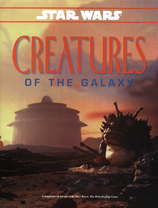 designers: Phil Brucato, Bill Smith, Rick D. Stuart & Chuck Truett
designers: Phil Brucato, Bill Smith, Rick D. Stuart & Chuck Truett
interior artists: Tim Bobko et al.
cover artist: Lucasfilm Ltd.
publisher: West End Games
publication date: 1994
cover: softcover
number of pages: 94
ISBN: 978-0-87431-221-8
description: This compendium contains creatures found in the Star Wars universe. Curiously, none of the creatures in this book appear in any of the movies. The book is compatible with Star Wars: The Roleplaying Game.
Our featured entry from this bestiary is the draagax.
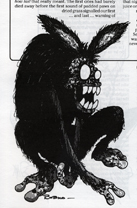 The draagax are a particularly nasty form of cave-dwelling hunter indigenous to the planet Relkass. Draagax are pack-oriented predators who hunt primarily along the planet's equatorial grasslands, living in the many caves that dot the neighboring foothills. Draagax feed primarily on the tall razorgrass and small rodents found in the region, but prefer the wild Relkass sentinel plant (a form of native cacti) that blooms in the dry season. It is during this time that the draagax are the most dangerous.
The draagax are a particularly nasty form of cave-dwelling hunter indigenous to the planet Relkass. Draagax are pack-oriented predators who hunt primarily along the planet's equatorial grasslands, living in the many caves that dot the neighboring foothills. Draagax feed primarily on the tall razorgrass and small rodents found in the region, but prefer the wild Relkass sentinel plant (a form of native cacti) that blooms in the dry season. It is during this time that the draagax are the most dangerous.
The Relkass sentinel plant contains a chemical compound which reacts as a powerful narcotic. Once in the bloodstream, even small amounts of plant toxin can send the average draagax into a berserker-like frenzy (which can last up to several hours). During this period the draagax will attack warm-blooded creatures on sight. In this they are aided by their ability to detect heat sources. Packs of berserker draagax have even been known to attack parties of unsuspecting Humanoids. For this reason, local officials offer large bountiese each year to cull the draagax population during the dangerous dry season, so as to minimize losses to local ranchers. Only the most experienced hunters apply for the job.
|
|
|
|
|
October 7, 2017
Dangerous Denizens: The Monsters of Tellene
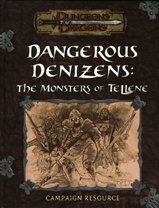 authors: Mark Plemmons et al.
authors: Mark Plemmons et al.
interior artists: David Hudnut et al.
cover artist: Talon Dunning
publisher: Kenzer & Company
publication date: 2003
cover: hardcover
number of pages: 224
ISBN: 978-1-88918-296-4
description: This compendium contains creatures found in the Kingdoms of Kalamar campaign setting. The book is compatible with the Dungeons and Dragons 3.5th edition.
Our featured entry from this bestiary is the tigerus lamia.
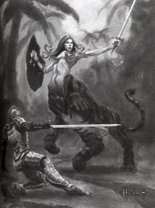 Tigerus lamia are noble, dignified creatures that prefer to live in solitude amongst their own kind. However, they can be most savage and retaliate in kind when attacked.
Tigerus lamia are noble, dignified creatures that prefer to live in solitude amongst their own kind. However, they can be most savage and retaliate in kind when attacked.
Tigerus live in small tribes, building wooden huts and leather lean-tos for their young. The elder, more traditional lamia still sleep in the open. Lamia favor raw meat, and eat their meals in communal fashion...Teigerus speak Celestial and Sylvan. However the lamia dialect of Sylvan is so distant from the actual language that a speaker of one can only make out two to three words in a sentence of the other. The more intelligent tigerus often speak a gravelly form of the local humanoid tongue.
Combat: The tigerus are nature's warriors and have been content in that role for centuries. When confronted with conflict, they are quick to engage, using their speed and agility to maneuver into position where they can use their strong legs and claws.
If conflict is not instigated, the tigerus appear to be a peaceful race. Such appearances fall away when the call of nature's defense is heard, and then they become rabid hunters and warriors, slaughtering transgressors without remorse.
On Tellene: The name tigerus is a Kalamaran adaptation of "tigurisnuk" (meaning "jungle lamia" in Goblin, roughly translated). The tigerus inhabited the Obakasek Peninsula (and what is now Tarisato) long before the Kalamarans migrated to their present home. While the dwarves lived beneath the earth mining precious metals, the tigerus lived above ground sleeping in the open and moving in small prides. Their chief rival for this jungle territory were goblins, though they were then much fewer in number and easily driven off. Such a life continued for centuries with little chagne until the first appearances of humans.
Reris, a Kalamaran logger, was the first to encounter the tigerus, as he understood them to be called. After their encounter with Reris (and the soldiers that followed), the lamia retreated from human civilization, choosing to confine themselves deep in the Obakasek Jungle. UnfortunateIy, the goblinoid population has greatly increased, and the tigerus now find themselves limited to small portions of the jungle, rarely venturing outside its canopy. Although explorers and adventurers have occasional contact with the tigerus, their presence on Tellene has, for the most part, been lost in the annals of history.
The tigerus worship the Bear, whom they call Grernenym, raising idols to it that reflect their own image. All creatures are welcome within the lamia's territory as long as they adhere to the teachings of Gremenym.
|
|
|
|
|
October 14, 2017
Monstrous Compendium Volume One
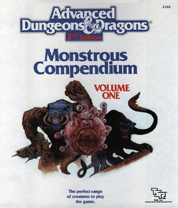 designer concept: David "Zeb" Cook, Steve Winter, Jon Pickens
designer concept: David "Zeb" Cook, Steve Winter, Jon Pickens
designer coordinator: Bruce A. Heard
interior artist: Jim Holloway
cover artist: Jeff Easley
publisher: TSR
publication date: 1989
cover: loose pages
number of pages: 152
ISBN: 978-0-88038-738-5
description: This compendium contains creatures found in the Advanced Dungeons and Dragons Campaign Setting. The book is compatible with Advanced Dungeons and Dragons second edition.
Our featured entry from this bestiary is the umber hulk.
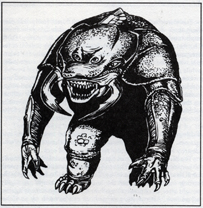 Umber hulks are powerful subterranean predators whose ironlike claws allow them to burrow through solid stone in search of prey.
Umber hulks are powerful subterranean predators whose ironlike claws allow them to burrow through solid stone in search of prey.
Umber hulks are tremendously strong, standing nearly 8 feet tall and over five feet wide. Muscles bulge beneath their thick, scaly hides and their powerful arms and legs all carry great claws. They have no necks to speak of, but the head features a powerful maw with rows of triangular teeth and 8-inch mandibles capable of biting through any hide or bone. Most peculiar of all are the four round eyes, spaced evenly across each umber hulk's forehead. Umber hulks are black, shading to a lighter shade of yellowish gray on the front. Their eyes are mere blackened dots each the size of a small coin. Umber hulks have their own language.
Combat: For all of their monstrous features, umber hulks are intelligent opponents, They usually dig to a point adjacent to a main corridor, then wait, peeking through a crack they've made, until likely prey walks by. The umber hulk then springs out upon its startled victim...
The one saving grace when fighting an umber hulk is their speed. Their gait is slow and ponderous and their balance is poor in wide spaces.
Ecology: Umber hulks eat young purple worms, ankhegs, and similar creatures. Their favorite prey, however, is humankind.
|
|
|
|
|
October 21, 2017
Monstrous Compendium Volume 2
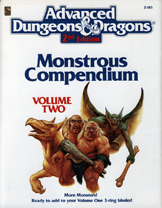 designer concept: David "Zeb" Cook, Steve Winter, Jon Pickens
designer concept: David "Zeb" Cook, Steve Winter, Jon Pickens
designer coordinator: Bruce A. Heard
interior artists: Jim Holloway & Daniel Horne
cover artist: Jeff Easley
publisher: TSR
publication date: 1989
cover: loose pages
number of pages: 152
ISBN: 978-0-88038-753-8
description: This compendium contains creatures found in the Advanced Dungeons and Dragons Campaign Setting. The book is compatible with Advanced Dungeons and Dragons second edition.
Our featured entry from this bestiary is the fomorian.
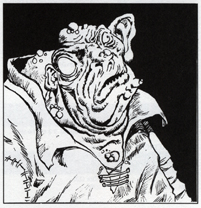 Fomorians are the most hideous, deformed, and wicked of all giant-kin.
Fomorians are the most hideous, deformed, and wicked of all giant-kin.
The fomorian giants are all grossly deformed behemoths. Each has a different set of deformities, which must be determined by the DM. A partial list of deformations includes misplaced limb, misshapen limb, misplaced facial feature, hunchbacked, bulging body part, drooping flesh, body part too big or too small, flapping ears, huge snout, large feet on short legs. Their thick, hairy hides, combined with the pelts and odd metal bits they wear for protection, give an effective AC of 3. They have scattered patches of hair as tough as wire on their pale white skin. Large warts and other growths are scattered across their bodies. There is no single odor associated with fomorians; some smell strongly due to overactive sweat glands, others have no smell . Their voices are also
each different due to heir unique deformities.
Combat: Fomorians use all manner of clubs and other blunt isntruments... Typical fomorian strategy is too sneak up on an opponent and hit him as hard as it can...
Habitat/Society: Their society is ruled by depravity and wickedness. The strongest and cruelest giant rules over all the others within reach, which is ususally a small number. The women andd children are treated as
slaves. Acts of violence are common among fomorians, sometimes resulting in permanent injury or death.
Ecology: These twisted giants can live for weeks on little or no food. Thia is good, because their underground dwellings do not provide an abundance of it. They can eat almost any organic material, including fungi, lichens, plants of all sorts, bats, mice and fish. They particularly savor the taste of large mammals, especially those that beg not to be eaten
|
|
|
|
|
October 28, 2017
Numenéra: The Ninth World Bestiary 2
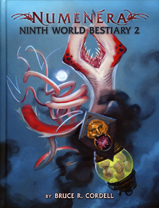 authors: Bruce R. Cordell
authors: Bruce R. Cordell
interior artists: Kieran Yanner et al.
cover artist: Kieran Yanner
publisher: Monte Cook Games
publication date: 2017
cover: hardcover
number of pages: 192
ISBN: 978-1939979643
description: This bestiary is associated with the Numenéra RPG.
Our featured entry from this bestiary is the ghru.
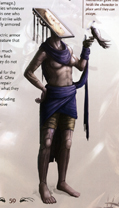 Ghru look very much like pale humans with large heads that resemble strange numenera devices, with glass panels for faces. On these panels, the project the image of a human face that speaks and makes expressions as a human would. Thus, ghru are humans with machine minds.
Ghru look very much like pale humans with large heads that resemble strange numenera devices, with glass panels for faces. On these panels, the project the image of a human face that speaks and makes expressions as a human would. Thus, ghru are humans with machine minds.
Ghru possess biomechanical brains they built in a processing plant that is more like a temple. Thus, they have certain skills and knowledge from their inception, but only some of it is useful. Despite this, thru have an understanding of machines and advanced knowledge like medicine, biology, and various machine sciences.
Interaction: It is difficult for a ghru brain to learn much beyond what is initially given. The ghru have fine memories and store new information, but they do not adapt well.
|
|
|
|
|
November 4, 2017
Monstrous Compendium Dragonlance Compendium
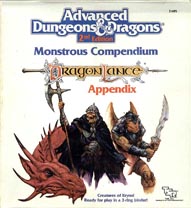 designer concept: David "Zeb" Cook, Steve "Old Man" Winter, Jon "The Paper Monster" Pickens
designer concept: David "Zeb" Cook, Steve "Old Man" Winter, Jon "The Paper Monster" Pickens
designer coordinator: Bruce A. Heard
interior artist: Mark Nelson
cover artist: Jeff Easley
publisher: TSR
publication date: 1990
cover: loose pages
number of pages: 100
ISBN: 978-0-88038-822-1
description: This compendium contains creatures found in the Dragonlance Campaign Setting. The book is compatible with Advanced Dungeons and Dragons second edition.
Our featured entry from this bestiary is shimmerweed.
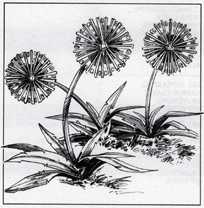 Shimmerweed is a most unusual, and beautiful, variety of plant that is found in temperate regions throughout the world. Although it is wholly inoffensive and has few natural enemies, shimmerweed can be one of the most dangerous things a party encounters as it strolls through the wilds of Krynn.
Shimmerweed is a most unusual, and beautiful, variety of plant that is found in temperate regions throughout the world. Although it is wholly inoffensive and has few natural enemies, shimmerweed can be one of the most dangerous things a party encounters as it strolls through the wilds of Krynn.
Shimmerweed is a type of wildflower that grows in small patches. Although on first inspection it looks much like a dandelion gone to seed, a closer look reveals that the plant consists of a crystalline material much like fine spun glass. Its beautiful and delicate appearance is enhanced by the way it catches rays of moonlight and refracts them through its petals, unleashing a dazzling spray of brilliant colors on the area around it. An average plant stands six to 18 inches tall.
Combat: Shimmerweed is unable to engage in any form of combat. It cannot move, has no means of inflicting damage on opponents, and is so delicate that the slightest of attacks instantly destroys it. Indeed, it has no motive at all to cause harm to other living things, as it feeds on moonlight.
The defense mechanism a shimmerweed patch has is its dazzling light show When the moonlight that feeds the plant is
caught in its crystalline petals, it is enchanted and becomes so brilliant as to affect all creatures who gaze upon it with a confusion spell...
Shimmerweed cannot tolerate bright sunlight on its delicate petals, thus it opens only at night. Those who come across it by day, in fact, are unlikely to take notice of the patch, for it looks like nothing more than a grove of common weeds. The plant's sensitivity to light is, however, a great weakness for it. Sudden exposure to a bright light source, such as a continual light spell, overloads its ability to draw nourishment with its petals, causing it to instantly shatter into fine dust. A patch destroyed in this manner is forever dead and cannot sprout again. Plants destroyed by any other means grow back in about one month.
The dangerous thing about shimmerweed patches is that many creatures use them to hunt prey. It is not uncommon for an intelligent monster or animal to set its lair near a patch of shimmerweed and wait for it to confuse travelers. Once the travelers are helpless, these lurking hunters spring to the attack and slaughter their prey.
Ecology: Shimmerweed is unique on the Prime Material plane for its unusual crystalline structure and its ability to feed directly on moonlight without use of photosynthesis.
|
|
|
|
|
November 11, 2017
Doctor Who: All the Strange, Strange Creatures Volume 1
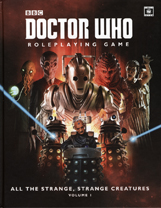 authors: Morgan Davie, Andrew Kenrick, Cassie Noble Beyer & Rob D. Webster
authors: Morgan Davie, Andrew Kenrick, Cassie Noble Beyer & Rob D. Webster
interior design & layout:Paul Borne
cover artist: Paul Borne
publisher: Cubicle Seven Entertainment Ltd.
publication date: 2016
cover: hardcover
number of pages: 160
ISBN: 978-0-85744-2980-2
description: This compendium contains aliens that Doctor Who has encountered on his adventures. The book is compatible with the Doctor Who Roleplaying Game.
Our featured entry from this bestiary is the dalek.
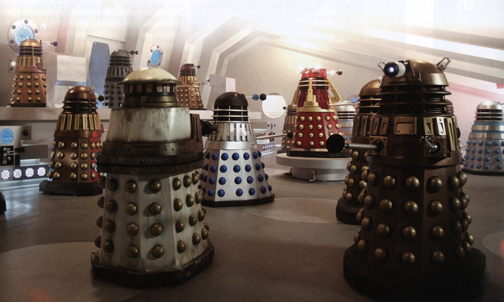 'Today the Kaled race is ended, consumed in a fire of war. But from its ashes will rise a new race: the supreme creature, the ultimate conqueror of the universe, the Dalek.'
'Today the Kaled race is ended, consumed in a fire of war. But from its ashes will rise a new race: the supreme creature, the ultimate conqueror of the universe, the Dalek.'
Devoid of all emotion other than hate, the Daleks mercilessly exterminate every other race in the universe, judging them inferior. Capable of time travel, the Daleks eventually rivaled the Time Lords in power, leading to the Last Great Time War and the near-total destruction of the universe.
Background: On the planet Skaro, the humanoid Kaleds and Thals waged a planet-wide, thousand year war that eventually went nuclear. The conflict continued even after the conclusion became obvious: near-total annihilation of all planetary life.
Recognizing genetic degradation to be the ultimate fate of the Kaled race, Davros, their chief scientist, accelerated the mutation process while deliberately manipulating DNA to reject weaknesses such as fear and mercy. Then, he placed his creations in life-supporting war machines to finish the war and survive as a new race: the Daleks.
Davros' programming worked too well. The Daleks considered themselves the superior lifeform not just on Skaro but throughout the universe, and even the Kaleds were not spared.
At first, the Daleks waged their genocidal war through conventional hyperdrive technology. Hungry for new military advantages and fed by the conquest of a thousand worlds, Dalek scientists began unravelling the secrets of time travel. While the Doctor could not stop them, he repeatedly delayed advancements...
Motives and Agendas: Simply ruling the universe is not sufficient. The Dalek's ultimate motivation is purging inferior races until nothing survives except pure Daleks. They show no mercy and make no exceptions. They hold no value in culture and assimilate nothing beyond what contributes to military superiority...
Dalek Biology: The Dalek mutant is a horror in its own right, a one-eyed, tentacled monstrosity. Its existence is integrated into its travel machine, the two fused through fluid and electrical conduits that allows the creature to operate the metal shell as an extension of itself. Nevertheless, it is possible, although painful, for the Dalek creature to detach itself and move on its own. Howver, they can only survive outside the life-support machines for an hour, so they abandon them only in dire circumstances.
The severe mutations suffered by the Daleks left them unable to biologically reproduce. Instead, they are grown in vats. They are not clones; rather, in their quest for perfection, Dalek scientists combined multiple strands of DNA for each new Dalek...
|
|
|
|
|
November 18, 2017
Starfinder Alien Archive
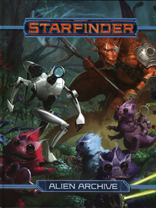 development leads: Jason Keeley, Owen K.C. Stephens & James L. Sutter
development leads: Jason Keeley, Owen K.C. Stephens & James L. Sutter
authors: John Compton et al.
interior artists: Helge C. Balzer et al.
cover artist: Remko Troost
publisher: Paizo Publishing
publication date: October, 2017
cover: hardcover
number of pages: 160
ISBN: 978-1-60125-975-2
description: This book contains over 80 creatures for a science fiction based campaign. This book is compatible with the Starfinder Role Playing Game.
Our featured entry from this bestiary is the asteray.
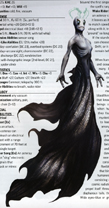 When humanoids first learned to ply the seas and oceans on Golarion, they encountered many beautiful and dangerous beings who cavorted in the waves and lured their vessels onto the rocks with enchanting songs. In time, they learned to differentiate the playful mermaid, the cruel rusalka, the bloodthirsty scylla, and their kin, and with that knowledge, the damage these strange beings could inflict was minimized. But when humanoids blasted into the stars, they found a new array of mischievous, mysterious creatures that threatened to lead their vessels into danger. Chief among these threats is the wily asteray.
When humanoids first learned to ply the seas and oceans on Golarion, they encountered many beautiful and dangerous beings who cavorted in the waves and lured their vessels onto the rocks with enchanting songs. In time, they learned to differentiate the playful mermaid, the cruel rusalka, the bloodthirsty scylla, and their kin, and with that knowledge, the damage these strange beings could inflict was minimized. But when humanoids blasted into the stars, they found a new array of mischievous, mysterious creatures that threatened to lead their vessels into danger. Chief among these threats is the wily asteray.
Delicate and angelic looking in zero gravity, asterays are a race of vacuum-dwelling fey that ride the solar winds between space debris, asteroid belts, and planetary rings, playing in the dust, dancing in microgravity, and seeking new and beautiful sights. Their bodies consist of little beyond lightweight, flexible bones and the powerful sinews that bind them together, creating a vaguely humanoid upper body and a lower body consisting of a large appendage that absorbs cosmic radiation and grants the fey the ability to propel itself through space. With elegant forms and diaphanous tails, they appear gentle and welcoming. Wide eyes--blue or green in color--express a variety of emotions, though apart from their eyes and the long, thin slit for a mouth, asterays have featureless faces. They are well adapted to life in the void, with sensitive vision, a variety of natural spells, and the capability to generate powerful bolts of electricity to defend themselves. They are also ravenous beyond compare. While space dust and solar radiation carry just enough nourishment to fuel their antics, asterays hunger for organic molecules. They pause their endless dances to scour asteroids and explore wrecked ships for sustenance. When food grows too scarce or boredom overwhelms them, asterays crawl into the dark corners of space and hibernate for weeks, months, or years at a time.
Often called "deep angels" for their habit of following ships through the vastness of space to scavenge any discarded treats and pick hulls clean of organic stowaways, asterays can also become menaces. The electronic signals they produce to communicate with one another mimic the sensor signals emitted by most starships, and in the eons that planet-bound creatures have explored their territory, asterays have learned to "sing" false sensor signals, mimicking ships' distress signals or cloaking navigational hazards such as high-density debris fields. Individual asterays are a danger only to smaller spacefaring vessels, but several working in tandem can lure even well-equipped warships to their doom thanks to their inherent magic. While few of these fey are cruel enough to hunt humanoids for food, they hold few qualms about eating whatever remains after a frightened crew ejects from a incapacitated starship, including the corpses of any fallen.
Asterays originally spawned in those few magic-rich star systems where the First World naturally overlapped with the
void. For eons, they remained confined to these backwater systems, unable to reach inhabited areas within their lifetimes, but the first mortal vessels to explore space provided the fey an exit. Asterays can ride the cosmic wakes of starships, regardless of their speed, hitchhiking on these explorers like remoras on a shark, and for much the same purpose. Today, most settled star systems boast at least a small colony of the capricious fey. Their domains are often in spots that have easy access to major space lanes, and they are marked by large cave-pocked asteroids where the asterays build their nests and hoard treasures. Wrecked ships invariably float through these spaces, often serving as new navigational hazards the fey either cloak with their sensor songs or use as tempting targets to lure in greedy scavengers.
While not inherently malicious, asterays are alien in mind and deed. They understand that most creatures need air, water, and food, but they have difficulty prioritizing others' needs over their own hunger and amusement. Much of their apparent cruelty and greed stems from this alien mindset and boredom; thus, those travelers who can amuse them or compel some level of empathy stand to gain powerful allies in the void.
A typical asteray is about 7-1/2 feet from its head to the end of its tail, though it could appear quite shorter if its lower appendage becomes bunched up or twisted. An average asteray weighs only 75 pounds.
|
|
|
|
|
November 25, 2017
Tome of Aliens
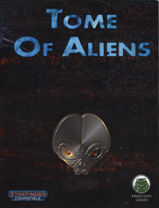 developer: Zach Glazar
developer: Zach Glazar
authors: anthony Pryor, Jeff Swank, Lance Hawvermale, Patrick Lawinger & Edwing Nagy
interior artists: Terry Pavelet and Artem Shukaev.
cover artist and designer: Jim Wampler & Charles Wright
publisher: Frog God Games
publication date: August, 2017
cover: softcover
number of pages: 42
ISBN: 978-1-62283-392-4
description: This book contains 60 creatures for a science fiction based campaign. This book is compatible with the Starfinder Role Playing Game.
Our featured entry from this bestiary is the cathode-ray troll.
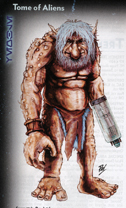 Thin, seven-foot tall, and incredibly ugly, cathode-ray trolls are a throwback to an ancient time. Ungainly with oversized head, hands, and feet, they move with a stumbling gait--arms outstretched and shoulders rolled forward. Generally solitary creatures, cathode-ray trolls live in remote cave systems, deep underground. They feed on the small vermin and the various species of blind fish found in their subterranean lairs. They try to avoid traveling far from the homes, as they hate to leave behind their most important treasure.
Thin, seven-foot tall, and incredibly ugly, cathode-ray trolls are a throwback to an ancient time. Ungainly with oversized head, hands, and feet, they move with a stumbling gait--arms outstretched and shoulders rolled forward. Generally solitary creatures, cathode-ray trolls live in remote cave systems, deep underground. They feed on the small vermin and the various species of blind fish found in their subterranean lairs. They try to avoid traveling far from the homes, as they hate to leave behind their most important treasure.
Each cathode-ray troll has its own cathode ray emitter (CRE). This cumbersome device sits as the central focus of its lair, usually raised on a stone pedestal so that its rays can fully bathe the space within the cave as they dance about at high speed. Each troll is attuned to its own frequency of electro-magnetic radiation. Most of them have devices that emit x-rays, but a few enjoy the benefits of ultraviolet or even visible light rays. While within 60 feet of their own CRE, a cathode-ray troll regenerates 10 HP per round and is immune to disease and poison. If only within 90 feet, it regenerates 5 HP per round but loses its immunities. Barring violence, cathode-ray trolls living near their emitters are practically immortal, able to live for thousands of years before the emitter"s radioactive power source dies out...
|
|
|
|
|
December 2, 2017
Alien Compendium: Creatures of the Verge
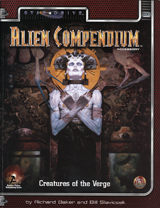 authors: Richard Baker & Bill Slavicsek
authors: Richard Baker & Bill Slavicsek
interior artists: Brian Despain et al.
cover artist: Brom
publisher: TSR
publication date: 1998
cover: softcover
number of pages: 128
ISBN: 978-0786-907786
description: This book contains more than 60 creatures for a campaign based in the Star*Drive Setting. This book is compatible with the Alternity Role Playing Game.
Our featured entry from this bestiary is the sesheyan.
 First encountered by a VoidCorp exploration venture more than two hundred years ago, the sesheyans are a primitive race barely out of their own Stone Age. Of all the alien species with whom contact has been made, the sesheyans received the poorest reception from humankind. With no regard for their culture, for their innocence, VoidCorp colonized their planet and dragged them from the formative years of their own civilization into humanity's sphere of interest. We'll never know how the sesheyans would have grown and evolved on their own, what kind of culture and civilization they would have made for themselves in the twilight deeps of heir forest-world. It seems nothing short of miraculous that the sesheyan people have survived this calamitous collision with the spirit of their species-their ways, their lifestyle-still intact.
First encountered by a VoidCorp exploration venture more than two hundred years ago, the sesheyans are a primitive race barely out of their own Stone Age. Of all the alien species with whom contact has been made, the sesheyans received the poorest reception from humankind. With no regard for their culture, for their innocence, VoidCorp colonized their planet and dragged them from the formative years of their own civilization into humanity's sphere of interest. We'll never know how the sesheyans would have grown and evolved on their own, what kind of culture and civilization they would have made for themselves in the twilight deeps of heir forest-world. It seems nothing short of miraculous that the sesheyan people have survived this calamitous collision with the spirit of their species-their ways, their lifestyle-still intact.
The sesheyan people are virtually indentured to VoidCorp, held in the heartless fist of that gigantic power. Visits to Sheya are strictly controlled by VoidCorp, and all other humans who have been allowed to meet the sesheyans on their homeworld have done so under heavy VoidCorp escort. Rumors abound of countless sesheyans conscripted into VoidCorpts armies or deported to the most remote and undesirable enterprises to be found within the megacorp's sprawling territory. Alien-rights activists throughout the COncord have vigorously protested VoidCorprs policies toward the sesheyan people, with little effect.
Description: In appearance, sesheyans are one of the most alien of the sentient species encountered by humanity to date. They are hexapedal flying creatures, with a pair of small forelimbs, powerful sweeping wings, and complex, double-jointed legs that end in clawed feet. In addition, sesheyans possess long, finned tails that flare open and act as stabilizers when the creatures are in flight. A typical 5" sesheyan is about the same height as an average human, but weighs in at only 40 idlograms-a sesheyan's skeleton is mostly composed of light, strong cartilage.
The sefheyan's head is wide and round, ringed by eight small eyes and crowned by two pointed ears. The blunt snout covers a hinged jaw full of sharp, bony ridges instead of teeth. Their hearing is as keen as a cat's, and their night vision is superior-but bright daylight virtually blinds them. Sesheyans are capable fliers, able to launch themselves into the air and easily stay aloft in any environment with a reasonably thick atmosphere (0.5 atm or greater) and relatively light gravity (1 g or lower). Having the ability to fly means that sesheyans never suffer damage from falling, as long as they are conscious and able to control their descent. They are adept at functioning in zero-gravity conditions, receiving the benefit of the Athletics-zero-g training skill at rank 1 without having to actually possess the skill.
Encounter: Most sesheyans are indentured Employees of VoidCorp. They're quite rare outside of VoidCorp territory, and even within space controlled by the megacorporation, sesheyans are mostly found in special supervised colonies. The "typical" sesheyan is a laborer, assigned to a camp or station far from his beloved forests and given drudge-work of the worst sort. VoidCorp also enlists sesheyans in its military forces and counterintelligence services; they're not spies by nature, but sesheyans have the mentality of a hunter and learn very fast.
The sesheyan personality is much more regimented than the human personality. While a human shifts from curiosity to fear to wrath in the space of minutes with no mental effort, a sesheyan views the changing of his emotional state or outlook as an undertaking with great spiritual consequences...
|
|
|
|
|
December 9, 2017
Creatures of Middle-Earth: A Bestiary of Animals and Monsters
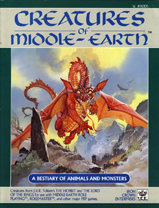 authors/designers: Ruth Sochard Pitt, Jeff O'Hare & Peter C. Fenlon, Jr.
authors/designers: Ruth Sochard Pitt, Jeff O'Hare & Peter C. Fenlon, Jr.
interior artist: Jim Holloway
cover artist: Angus McBride
publisher: Iron Crown Enterprises
publication date: 1988
cover: softcover
number of pages: 64
ISBN: 1-55806-019-7
description: This compendium contains animals and monsters from J.R.R. Tolkien's Middle-Earth. The book is compatible with the Middle-Earth Roleplaying Game, first edition.
Our featured entry from this bestiary is the pûkel-man.
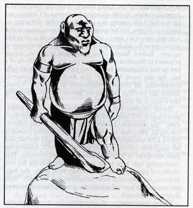 Pûkel-creatures are animated stone or metal monsters magically instilled with enchanted spirits. Most are creations of the Drúadan, or "Wose," culture. Others are the work of the Daen Coentis, a proto-Dunlending people of the White Mountains among whom the Woses lived and worked. Realizing the value of these stone guardians, Sauron has also produced a plethora of Pûkel-creatures, the most famous of which are his Watchers.
Pûkel-creatures are animated stone or metal monsters magically instilled with enchanted spirits. Most are creations of the Drúadan, or "Wose," culture. Others are the work of the Daen Coentis, a proto-Dunlending people of the White Mountains among whom the Woses lived and worked. Realizing the value of these stone guardians, Sauron has also produced a plethora of Pûkel-creatures, the most famous of which are his Watchers.
Pûkel-men are lifelike stone carvings carved to resemble their creators, the Drúadan (aka "Drughu" or "Drûgs"). They are generally employed as guardians of sacred areas. As enduring as the stone that they are made of, they are subject to chipping, weathering , and other such perils. Pûkel-men show surprising initiative for artificial beings: they appreciate the power of ambush and prefer this mode of attack to any other. In addition, they are stealthy trackers and stalkers. However, when utterly shattered or when their features are worn away by weather, Pûkel-men become inactivated. In a sheltered place, Pûkel-men may remain potentially functional for millennia.
|
|
|
|
|
December 16, 2017
Men in Black Alien Recognition Guide Volume 1
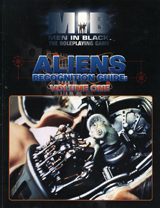 authors: Ed Bolme, Tina Gharavi, Adam Gratun, Evan Jamieson & Richard Meyer
authors: Ed Bolme, Tina Gharavi, Adam Gratun, Evan Jamieson & Richard Meyer
interior artists: Tim Bobko, Tom Oneill & Brian Schomburg
cover artist: Brian Schomburg
publisher: West End Games
publication date: 1997
cover: softcover
number of pages: 82
ISBN: 0-87431-391-0
description: This compendium contains aliens from the Men In Black franchise. The book is compatible with the Men In Black Roleplaying Game.
Our featured entry from this bestiary is the squorp.
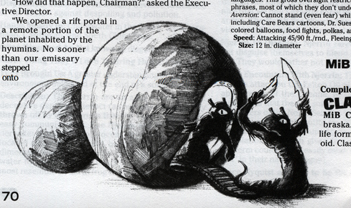 MiB Case File: UFOs
MiB Case File: UFOs
MiB Classification: Nebraska. Anti-matter-based life form. Tenebrous spheroid. Class Phi.
But You Can Call Them: UFOs.
Also Known As: Flying black-thingees.
Disposition: Believed warlike...at least that's what the survivors indicate.
Hangs Mostly In: Another universe, self-made war zones.
Often Disguised As: Floating spheres of pure black, floating spheres of pure blue, basketballs, cantaloupes.
Earth Thing They'd Love to Bring Home: Earth.
They Brought Us: The chance to be conquered in spite of the Tycho Accord. Skeet shooting.
Description: The Squorps in their normal form resemble snails without their shells. Squorps are invertebrates and remain upright by use of huge dorsal muscles.
Physiological Quirks: Occasionally explode mightily when hit with positive matter, also exhibi fear of cheery or whimsical music and poetry.
|
|
|
|
|
December 23, 2017
Star Wars Galaxy Guide 4: Alien Races
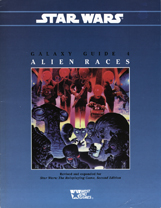 authors: Troy Denning
authors: Troy Denning
interior artists: Michael Manley, Aaron McClellan & Ralph McQuarrie
cover art: Lucasfilm Limited
publisher: West End Games
publication date: 1994
cover: softcover
number of pages: 96
ISBN: 0-87431-208-6
description: This compendium contains aliens from the Star Wars universe. The book is compatible with Star Wars: The Roleplaying Game, Second Edition.
Our featured entry from this bestiary is the whiphid.
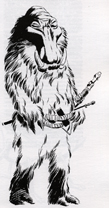 Appearance and Biology: Whiphids are hulking bipeds with long, yellow-white or golden fur, and stubby, furred tails. They stand up to two and a half meters tall, and weigh up to 400 kilograms. The Whiphid face, which has a prominent forehead and long, bowed cheekbones, is hairless - except for a few spiky hairs on its leathery lips and chin. Two upturned tusks sprout from the jaw, and the eyes protrude slightly.
Appearance and Biology: Whiphids are hulking bipeds with long, yellow-white or golden fur, and stubby, furred tails. They stand up to two and a half meters tall, and weigh up to 400 kilograms. The Whiphid face, which has a prominent forehead and long, bowed cheekbones, is hairless - except for a few spiky hairs on its leathery lips and chin. Two upturned tusks sprout from the jaw, and the eyes protrude slightly.
Though they are usually hidden by fur, the three thick, strong fingers of the Whiphids end in steely, flesh-ripping claws.
Temperament: Whiphids are ferocious predators that have a true love of the hunt. They enjoy nothing more than tracking something down and killing it, but can actually be pleasant companions - capable of expressing a wide range of emotions - provided you can convince them that you are not prey.
As they interact more with the greater galaxy, the Whiphids are starting to understand the differences between sentients and non-sentients (there are exceptions), and are learning to direct their predatory instincts only towards non-sentient creatures.
History and Culture: Whiphids live on Toola, which, because of its thin atmosphere and the distance from its sun, Kaelta, is bitterly cold. Summer does come to some regions of Toola, and, during those brief periods of time, the grasses grow and flourish, drawing half-starved caraboose and hoary mastmots onto the plains for grazing, but for most of Toola's year, Whiphids know only glaciers, snow, and gleaming bergs of steel blue ice.
The Whiphids do not mind the temperature variations. Their fur and a thick layer of fat enables them to preserve their body heat. Their fur also sheds water, enabling Whiphids to swim freely in the frigid seas. Then, when the brief summer arrives, the Whiphids shed several centimeters of fur and burn off much of their fat, and their hollow cheeks widen, creating a broader face to help dissipate heat.
Whiphids live in small nomadic tribes of three to 10 families. Each community builds a permanent shelter of rocks, skins, and mastmot bones to which they return each summer. During the winter months they migrate across the snow fields, following food and building temporary shelters in the snow.
Politics: In as much as they have leaders, Whiphid tribes are lead by the most successful hunter, an individual often given the title, Spearmaster. The Spearmaster of a tribe has absolute authority in two areas: where the tribe camps, and what quarry it hunts. In all other areas of life, Whiphid individuals will acknowledge no leaders; they make their decisions according to their own knowledge.
While this would seem to be arecipe for chaos, it, in fact, works quite well in the Whiphid culture (although this may be largely due to the fact that most other aspects of life on Toola are of little importance).
Technology Level: The Whiphids have developed some primitive metalworking capabilities, but have made few other technological advances.
|
|
|
|
|
December 30, 2017
Baby Bestiary 2
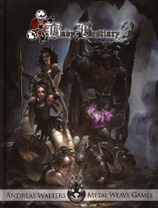 creative director: Andreas Walters
creative director: Andreas Walters
interior artists: Conceptopolis et al.
cover artist: Conceptopolis
publisher: Metal Weave Games
publication date: 2016
cover: hardcover
number of pages: 96
ISBN: 978-1-987916-40-9
description: This bestiary contains entries for 41 relatively well-known beasts in their baby stages. The book is designed to be system- and setting-neutral, so it does not contain stat blocks.
Our featured entry from this bestiary is the myconid sporeling.
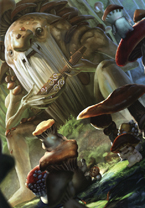 Of all the strange creatures described within these pages, myconids may well be the strangest. It's impossible to raise a young myconid, at least deliberately, although if you live in a damp, well-wooded area then you may find you have raised some quite by accident. In truth the fungoid beings we call "myconids," even at their smallest and cutest, are already well advanced in years.
Of all the strange creatures described within these pages, myconids may well be the strangest. It's impossible to raise a young myconid, at least deliberately, although if you live in a damp, well-wooded area then you may find you have raised some quite by accident. In truth the fungoid beings we call "myconids," even at their smallest and cutest, are already well advanced in years.
Each begins life as a sentient network of millions of microscopic filaments spread throughout the soil. These networks overlap one another, and range in size from a few square feet to an entire forest. In a sense, they are the earth itself come to life, although the nature of that life is so alien to most thinking beings that communication is near impossible, let alone understanding. Nonetheless, this constitutes decades-sometimes even centuries-of a myconid's life, during which they form social groups, teach young filaments the ways of their culture, invent songs, tell stories and generally live rich and meaningful lives.
Myconids as we know them emerge only in their later years, when they're ready to procreate. This is no matter of simple copulation; myconids seek true love, and will remain in their humanoid forms for as long as it takes to find it.
While aboveground, they gather in colonies and are welcoming to visitors, but tend to avoid contact with the other civilizations. This may be inherited caution, since they have historically been blamed as the source of ruined crops or even plagues. It doesn't help that they cannot form words in any tongue, mostly communicating with outsiders via gestures. Among themselves, myconids commune through touch, soft humming, and the beautiful fungal tapestries they leave behind to tell their stories.
When two or more myconids fall in love, there is a short but intense courtship period, after which they perform their mysterious mating ritual in a private grove under the full moon. This aspect of myconid culture is a closely guarded secret; all we know for sure is that it culminates at sunrise with the lovers sinking to the ground to die in each other's arms. Their colony will bury them where they lie and, as their bodies break down, their children will be released from within to begin their own unfathomable, earthy lives.
General Care: Myconids feed off decay, although not out of sinister intentions; it is simply their diet, which they see as connecting them to the natural cycle of life and death. They prefer rotting wood, but can eat any decomposing organic matter. Around non-myconids they tend to be very private about meals, probably because the other beings are easily unsettled by their eating habits and choice of food.
Smaller myconids have sensitive skin and bruise very easily, so great care must be taken in touching
them. They respond affectionately to gentle stroking, especially when accompanied by music.
Rearing:
Even a newly-sprouted myconid bears a thorough education from their time underground, but should you find yourself raising one away from a colony, they'll need special supervision. They will know which yellow algae can heal their wounds and how to deter a hungry dire-wombat, but not how to avoid moving carts or why the hay packed into a bed frame is not for storing rotting food. They're uncomfortable in sterile environments, and deeply frustrated by other
humanoids' need to control growing things. To them if a poisonous plant has sprouted in a town park, its ability to survive there merits respect, not destruction. It's hard to know whether a myconid ever truly understands what you say to them, but if they trust you they will allow themselves to be directed.
Myconids who have not yet found love can last aboveground for decades, and continue to grow in stature throughout. If you're hard-hearted enough to keep yours solitary, it will eventually be as big as a house, although myconids who reach this age and size become increasingly indrawn and may only move a couple of times a year. If you prefer to help your companion in its quest, take it traveling; colonies can be found in most woods, and will gladly welcome newcomers seeking their soulmates.
|
|
|
|
|
Continue to late addition (2018) entries.
|
|
|
|
|
|
|
|

